Combined Shape .st0{fill-rule:evenodd;clip-rule:evenodd;fill:#fff} region-beach-cities-lax region-downtown region-hollywood region-valley region-westside .st0{fill-rule:evenodd;clip-rule:evenodd;fill:#fff} SMS Main navigation Things to Do Attractions & Tours Arts & Culture Outdoors & Wellness Shopping Family Hidden Gems Luxury Pet-Friendly Eat & Drink Bars Clubs Dine LA Restaurant Week Restaurants Business Spotlight Find Events Itineraries Where to Stay Celebrate LA Heritage AAPI Heritage Black LA Latino Heritage LGBTQ+ Tourist Information Meetings About LA Tourism Travel Trade Membership Business Spotlight Media Research Careers Today's must read The Guide to Outdoor Music in Los Angeles Log in Search Search Things to Do Arts & Culture Mak Center For Art & Architecture at Schindler House Share Been There Login Register My Next Trip Login Register Get Directions Go Metro Website Arts & Culture Convention Services Event/Alternative Meeting Venue Architecture Art Family Friendly Museums Eclectic Historic Follow Us: Behind a bamboo grove, the Schindler House offers a tranquil setting for meetings, receptions and parties. A modern masterpiece designed in 1922 by R. M. Schindler, it features sliding doors opening onto courtyards, outdoor fireplaces and lush landscaping. Contact Information 835 N. Kings Rd., West Hollywood 90069 323-651-1510 Hours Wed - Sun: 11 am - 6 pm


Discover LA Newsletter

Visiting the Schindler House
Southern California is a treasure trove of historic homes. From the Arts and Craft splendor of T he Gamble House to the Victorian elegance of the Bembridge Hous e to the adobe charm of Rancho Los Alamitos there’s something for everyone to enjoy.
One of the most unique homes in SoCal, the Schindler House , is located in West Hollywood.

The house, designed by famed architect Rudolph Schinder, was built in 1922. It was designed as a communal space for two couples – Schindler and his wife, Pauline and Clyde and Marian Chace.

Schindler stayed in the house until his death in 1953 and Pauline remained through the 1970’s. In 1980 the house was acquired by the non-profit Friends of the Schindler House and today is a museum and home of the Mak Center for Art and Architecture .

I stopped by the house one Friday afternoon when admission was free (it’s free every Friday from 4-6pm). It was the perfect time to visit as there were only a few other visitors and often I had rooms all to myself.

The house remains very much as it was the day it was built with minimal furnishings and decor. As I wandered around I couldn’t help but think it was one of the most unique spaces I had ever been in.

Schindler is one of the fathers of the modernist movement and this house is where it all began. With walls of concrete and an abundance of straight lines and sharp edges it’s unlike anything of it’s era.

While not a house I would ever want to live in I felt very much at peace during my visit. Set back from the street, surrounded by a wall of bamboo and cool and quiet it’s an oasis in the middle of the city.

It’s a house that’s unmistakably a part of LA yet it keeps LA at bay. It’s an enigma that’s well worth investigating and I’m glad I did.
Looking for more content?
Leave a reply cancel.
Notify me of follow-up comments by email.
Notify me of new posts by email.
This site uses Akismet to reduce spam. Learn how your comment data is processed .
Find anything you save across the site in your account
Celebrating the Centennial of (Arguably) the World’s First Modern House, in West Hollywood

A century ago, a strange edifice arose at the foot of the Hollywood Hills, on Kings Road. It was a single-story structure of gray concrete walls and redwood ceilings, shorn of ornament. Before landscaping, it had an austere appearance, resembling a low-lying fort. You can catch a glimpse of it in Buster Keaton’s 1924 comedy “Sherlock Jr.”: when the protagonist zips down Kings Road , perched on the handlebars of an errant motorcycle, the house at 835 glowers unamused in the background. Few moviegoers could have been aware that they were seeing an early marvel of modernist architecture—a house that acts, in the words of the critic Reyner Banham, “as if there had never been houses before.”
The architect was Rudolph Michael Schindler, who had come to America from Vienna in 1914, steeped in the influence of Otto Wagner, Adolf Loos, and Frank Lloyd Wright. He designed 835 Kings Road as a communal residence for himself, his wife, and two married friends—“a cooperative dwelling for two young couples,” he called it. He lived there from 1922 until his death, in 1953. Pauline Gibling Schindler, his wife and later ex-wife, stayed until 1977. For decades, Schindler’s work received little critical attention, and, in the seventies, the house on Kings Road might easily have been razed to make room for a condominium. But Schindler’s heirs, passing up a financial windfall, sold the property to an organization called Friends of the Schindler House ( FOSH ), which owns it to this day. Tours and programming are operated by the MAK Center for Art and Architecture, an L.A. outpost of the Museum for Applied Arts, in Vienna.
The Schindler House has aged into a becalmed, almost rustic, refuge. Condos rise on either side of the lot, but once you reach the end of the path that runs from the street you have left the metropolis behind. Citrus trees, privet hedges, stands of bamboo, and vegetable gardens create a lush environment. The concrete walls, which tilt inward as they rise, possess an ancient aura. Tall, narrow gaps appear at forty-five-inch intervals, like arrow slits in medieval castles. Sliding patio doors suggest a Japanese influence. Schindler compared the house to a “camper’s shelter,” having had a transformative experience camping in Yosemite in 1921. Last summer, not long after the house had reopened in the wake of a pandemic shutdown, I spent a morning there. I was almost the only visitor, and I fell into a happy stupor, lost in time.
This summer, crowds have returned, as the house celebrates its centennial and raises funds for ongoing restoration projects. On a recent Saturday, FOSH held a day of talks and tours, with a familial atmosphere predominating. The scholar Todd Cronan donned a white, open-necked tunic—one of Schindler’s favored fashions—to read from the architect’s writings. “Modern architecture lies down flat on the ground like a kitten who suns itself,” Cronan proclaimed, reciting from a 1938 lecture. Guillaume Schindler, the architect’s great-grandson, also participated, with Mary Schindler, Guillaume’s ninety-nine-year-old grandmother, looking on. The architectural historians Judith Sheine and Robert Sweeney—the latter the president of FOSH —offered insights.
Most of the audience probably already knew the narrative that emerged from the readings: that of a proud, independent spirit who had been overlooked by the architectural heavyweights of his time. We shook our heads at dismissive remarks by Philip Johnson and Henry-Russell Hitchcock, who omitted Schindler from a pivotal 1932 exhibition at the Museum of Modern Art. We laughed ruefully when the panel shared some of Schindler’s correspondence with the monstrously egotistical Wright. In 1929, Schindler was trying to get Wright to supply a letter of recommendation so that he could obtain a license from the Board of Architects of Southern California. Wright sent along several drafts of letters to the board, which ranged from the uselessly belligerent (“He is worth any ten of you”) to the uselessly perfunctory (“He has built quite a number of buildings in and around Los Angeles that seem to me admirable from the standpoint of design, and I have not heard of any of them falling down”). Although Schindler kept busy building houses around Southern California, he never won larger-scale contracts.
The Schindler renaissance took off in the sixties and seventies, when a more pluralistic architectural philosophy came into vogue. His buildings, for all their modernist features, had been too asymmetrical and freewheeling to fit the strictures of the International Style. Banham, a prophet of the new sensibility, wrote of Schindler’s early work: “What it means, historically, is this—that modern architecture would have happened in California even if de Stijl, Corb[usier], Mies, Gropius, and the Museum of Modern Art had never existed.” Kathryn Smith, in a 2001 book about Kings Road , called it “the first modern house to be built in the world.” This is arguable: Schindler had his own antecedents, taking inspiration not only from Wagner, Loos, and Wright but also from the innovative Southern California architect Irving Gill. Native traditions made their impact, too: on a trip to the Southwest in 1915, Schindler admired the massive, unadorned façades of Pueblo adobe construction.

Debates over priority will never end. A better way to celebrate the Schindler House is to see it not simply as an individual achievement but as a collective social experiment. Its floor plan is implicitly egalitarian. Three L-shaped wings are arranged in a pinwheel pattern, each wing containing studio spaces for the couples and for a guest. A kitchen or “utility room” serves as a common area, encouraging shared duties instead of creating, as Schindler wrote, “a disagreeable burden to one member of the family.” At the same time, the layout insures a degree of privacy for the couples: each “L” unit has sliding canvas panels that open onto a secluded court.
The plan owes much to the philosophy of Pauline Gibling, who met Schindler in Chicago, in 1918, at a performance of Prokofiev’s “Scythian Suite.” Gibling, who studied music at Smith College before branching out into writing, criticism, education, and activism, had imagined a place like the Schindler House as early as 1916, writing of “a little joy of a bungalow, on the edge of woods and mountains and near a crowded city, which shall be open just as some people’s hearts are open, to friends of all classes and types.”
Gibling set the tone for life at 835 Kings Road, fostering a bohemia that rivalled any in Greenwich Village. The architect Richard Neutra , who had known Schindler in Vienna, moved in with his family when he arrived in Los Angeles, in 1925. Residents included the dancers Katherine Dunham and John Bovingdon, the modern-art maven Galka Scheyer, and, very briefly, the young composer John Cage . Upton Sinclair, Edward Weston, and Aldous Huxley were frequent guests. Salons and concerts were organized; at one, Cage and Henry Cowell presented an evening of Japanese gagaku, and, at another, the German-Japanese poet Sadakichi Hartmann, formerly a Village mainstay, impersonated Edgar Allan Poe. Extramarital affairs were conducted, including an unlikely one between Gibling and Cage.
Like many utopian enclaves, this one frayed over time. By 1927, the Schindler marriage had gone into crisis, and Gibling moved out; the couple divorced in 1940. Gibling returned to the house full time in the late forties, continuing to write perceptively about her ex-husband’s work even when the two were not on speaking terms. (Schindler sent her a note one day: “If you paint your part of the house . . . my struggle for expression and the resistance of the unsensitive would receive another monument.”) Schindler’s friendship with Neutra soured in the thirties. Still, gatherings on Kings Road remained vibrant and diverse. Mary Schindler told me that she once encountered Robert Oppenheimer there.
The MAK Center has installed an array of exhibitions at the house for the centennial, aiming to evoke its rich history without indulging in mythmaking. Jia Yi Gu, the MAK Center’s director, told me, “We don’t want to buy in to the idea of a genius architect making use of empty space, as if no one had lived here before.” In one room, the conceptual artist Kathi Hofer had arranged reproductions of archival materials in vitrines, confronting viewers with a clause in the original deed: “That said property shall not at any time be leased, sold, devised or conveyed to, or inherited by, or otherwise become the property of, any person other than of the Caucasian race.” Judge Albert M. Stephens, the chief seller of the land, was a Confederate veteran, and his first wife, Matilda, had presided over the California chapter of the United Daughters of the Confederacy.
In the monumental sprawl of modern-day Los Angeles, Schindler’s utopian ethos collides with realities of extreme inequality and environmental waste. At the same time, it offers a way forward. Nothing in Schindler’s work is more admirable than his way of carving out open-feeling domiciles in limited space. He expanded on that philosophy in his small-scale apartment complexes, such as El Pueblo Ribera Court, in La Jolla; the Bubeshko Apartments, in Silver Lake; and the Laurelwood Apartments, in Studio City. All these feature private patios ingeniously nestled among units in close proximity. It’s a way of creating a breathable kind of privacy without appropriating tracts of expensive land.
The most touching moment at the centennial event came when occupants of Schindler residences spoke about the experience of inhabiting the architect’s world. Two residents at the Falk Apartments, also in Silver Lake, alluded to the history inherent in the place. When they first moved in, more than two decades ago, their neighbor was the screenwriter and labor activist Joan Scott, who told stories of Hollywood idealism in the thirties and forties and of the McCarthyite repression that followed. (Scott’s husband, Adrian, was one of the blacklisted Hollywood Ten.) One of the residents said, “I still notice the shadows, I notice the light, and I notice the soft rounded corners. Mostly, it’s love—in the care and attention of construction. I wholeheartedly believe that Mr. Schindler thought about the future and thought about the people who would inhabit his spaces. His soul lives on.” ♦
An earlier version of this article misidentified the material of the house’s sliding panels .
New Yorker Favorites
An Oscar-winning filmmaker takes on the Church of Scientology .
Wendy Wasserstein on the baby who arrived too soon .
The young stowaways thrown overboard at sea .
As he rose in politics, Robert Moses discovered that decisions about New York City’s future would not be based on democracy .
The Muslim tamale king of the Old West .
Fiction by Jamaica Kincaid: “ Girl .”
Sign up for our daily newsletter to receive the best stories from The New Yorker .

As the Schindler House turns 100, a new exhibition reexamines its complex legacy
Jakob Sellaoui’s “Uncomfortable Pavilion,” 2022, pays homage to the Schindler House. (Carolina A. Miranda / Los Angeles Times)
- Copy Link URL Copied!
The history of Rudolph Schindler’s 1922 house is a quintessential Los Angeles story: a story of new ideas that are rapidly devised and rapidly dismissed, only to reemerge years later as pioneering and influential.
Built on an empty lot at 835 N. Kings Road in West Hollywood, then a scrubby unincorporated suburb of L.A., the Schindler House was indoor-outdoor and open plan decades before these were a thing — an intersecting sequence of multipurpose “studiorooms” that spilled into courtyards via sliding doors. The very DIY affair consisted of tilt-up concrete panels that two men could put into place with rope and a hoist. In fact, Schindler and his friend, engineer Clyde Chace, did some of the work themselves. Then, they and their wives, Pauline Gibling Schindler and Marian Chace, respectively, moved in.
The home’s innovative attributes — its rough-hewn aesthetic and attention to space — earned Schindler the admiration of fellow architects and a clutch of adventurous patrons, but it was generally ignored by the U.S. architectural establishment. For decades, the house was more cult hit than fan favorite. “Schindler is an architect’s architect,” Los Angeles critic Esther McCoy wrote in 1945.
For a time, it seemed he was destined to remain just that. When Schindler died in 1953, his (very brief) obituary in The Times made mention of the mechanical-looking beach house he’d built for wellness guru Philip Lovell in Newport Beach — but not the avant-garde home he had designed for himself.
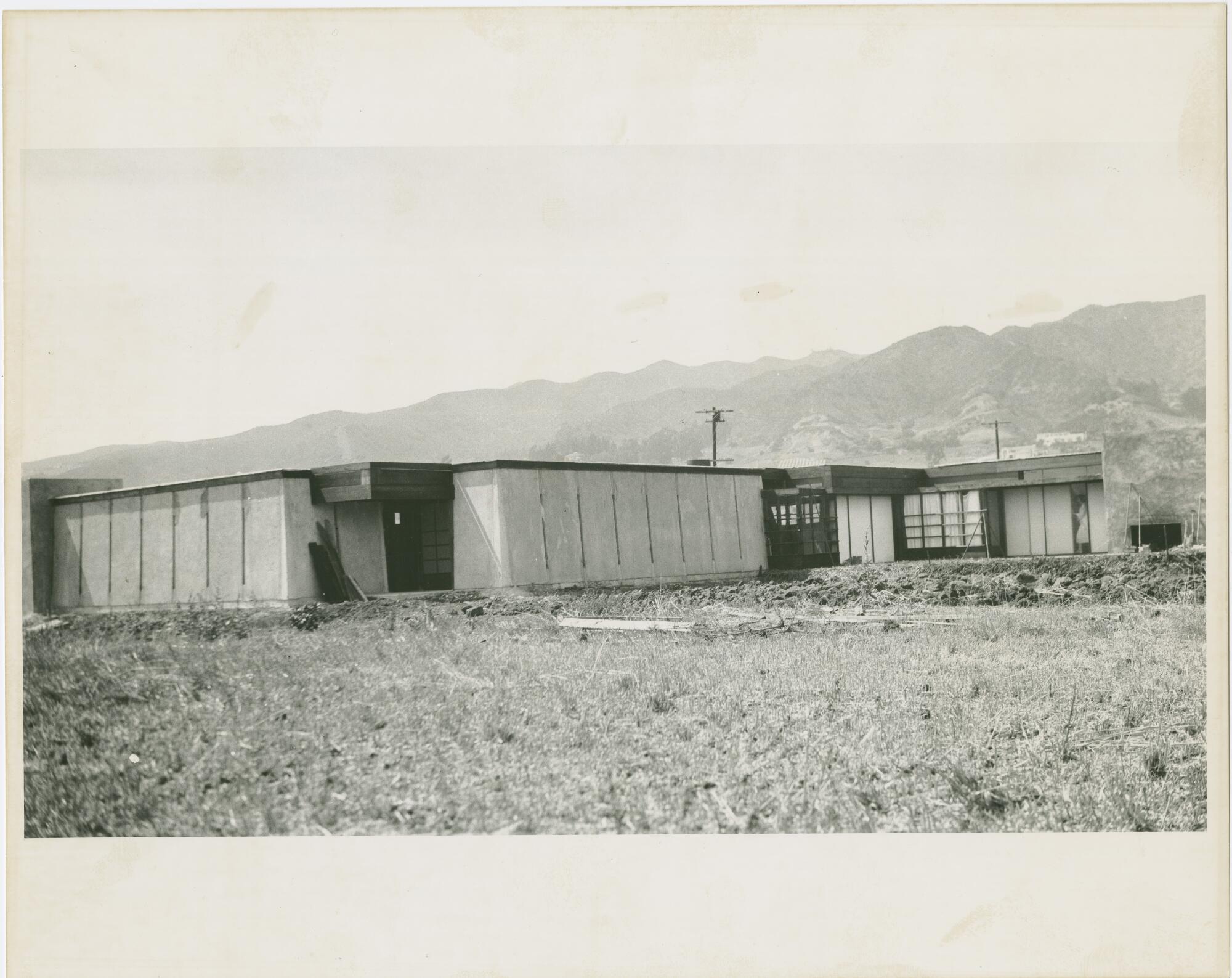
A century later, the story has come full circle.
As David Gebhard and Robert Winter wrote of the Schindler House in the 2018 edition of “ An Architectural Guidebook to Los Angeles ,” “It is a classic in Modern architecture, and we use the word sparingly.”
Evoking elements of traditional Japanese design and Viennese Modernism (Schindler was born in Austria), the home — with its flat roof and sliding doors — helped point the way for domestic architecture in the United States.
Marking its centenary is a new exhibition organized by the MAK Center for Art and Architecture that features an array of public programs, including lectures, performances, audio tours , “edible” poetry and even an opera. Curated by MAK Center Director Jia Yi Gu, Gary Riichirō Fox of the Getty Research Institute and historian Sarah Hearne, “Schindler House: 100 Years in the Making” brings together, within Schindler’s home, art, artifacts and objects that speak to its legacy.
ARCHITECTURE : Experimentation Was the Moving Spirit Behind Schindler House
In the 1920s, when West Hollywood was an expanse of bean fields stretching between oil derricks to the south and the hills to the north, the area became a haven to an eclectic group of artists, poets and architects.
Feb. 7, 1991

This is not an exhaustive historical survey. (For that, it’s best to locate the informative catalog for “The Architecture of R.M. Schindler,” a thorough review of Schindler’s work displayed at the Museum of Contemporary Art Los Angeles in 2001.) The MAK show serves more as a meditation on several themes, including L.A. in the early 20th century, the home’s role as a gathering site and the way it has evolved over the years.
The exhibition follows another recent Schindler House-inspired show, “ 835 Kings Road ,” curated by Silvia Perea at the Art, Design & Architecture Museum at UC Santa Barbara (which holds Schindler’s papers ). That exhibition, which concluded in May, featured a fictional installation by artist Mona Kuhn, with a soundtrack by Boris Salchow, inspired by Schindler’s romantic life and the home’s bohemian vibe.
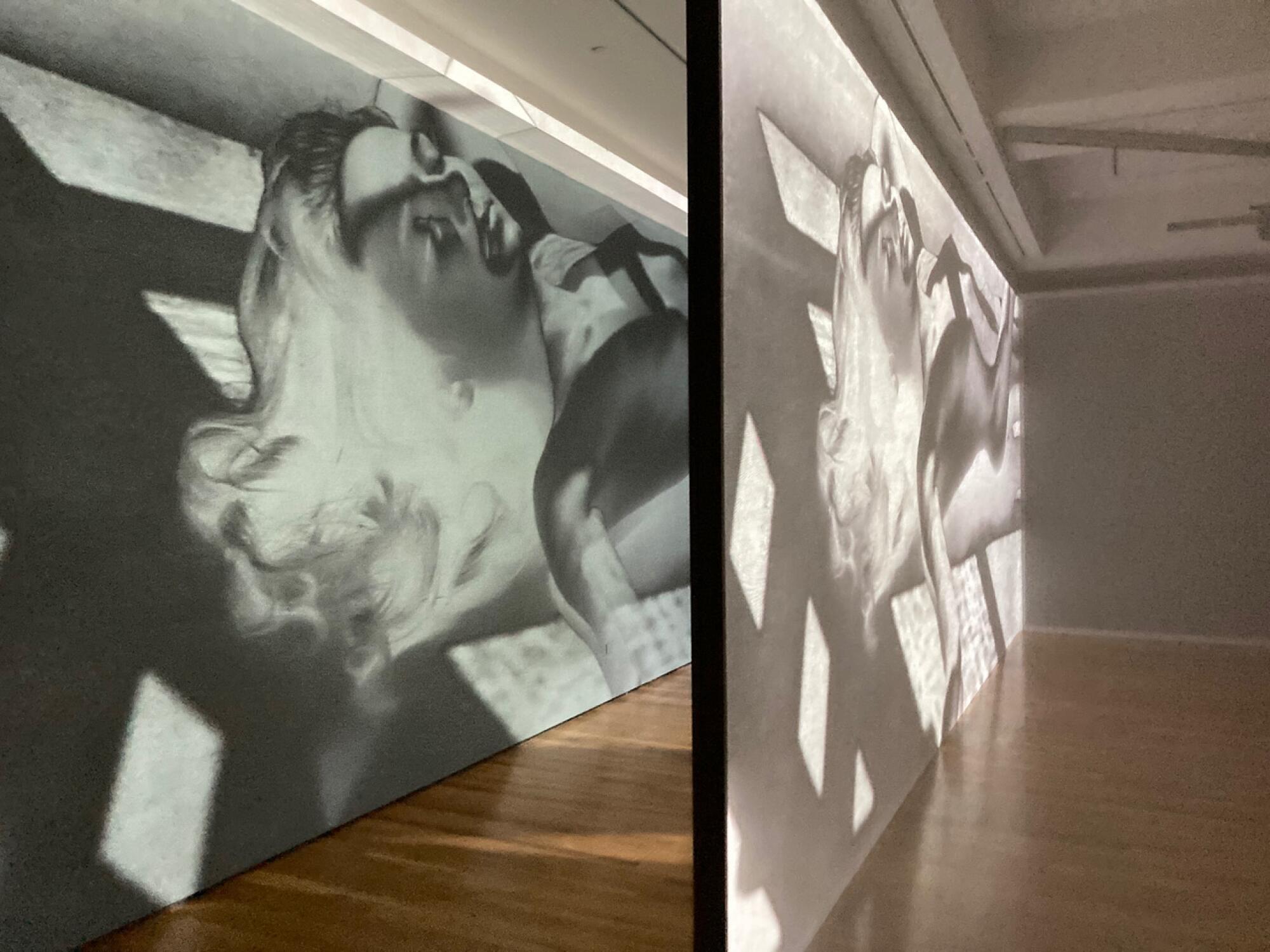
In its day, Schindler’s house was indeed the happening spot for L.A.’s radical set.
Much of this was thanks to Pauline, a composer and writer who used the house as a stage. There were salons, poetry recitals and dances — at least one of which, to the horror of neighbors, transpired in the nude. After the Chaces relocated to Florida in 1924, their studios were occupied by figures such as composer John Cage and collector Galka Scheyer . When fellow Austrian architect Richard Neutra moved to Los Angeles in the 1920s, his first home was the Schindler House.
Famously — or rather infamously — Schindler and Neutra were friends and collaborators until their relationship was ruptured by conflict over a commission, a years-long schism that came to an end in 1953 when the two, purely coincidentally, ended up sharing a hospital room. Neutra was recovering from a heart attack, and Schindler was being treated for the cancer that would claim his life that year.
He was 65 when he died, an age at which many architects are just getting started.

Entertainment & Arts
An Esther McCoy revival tells story of L.A.’s modern architecture
Dec. 18, 2011
“Schindler House: 100 Years in the Making” opens with a large-scale reproduction of a manuscript page by McCoy that details aspects of the home’s restoration in the 1980s under the auspices of the Friends of the Schindler House, a not-for-profit group that took on the property after Pauline’s death in 1977. (Currently, the house is owned by the Friends but its programming is overseen by the MAK Center.)
McCoy, who had worked in Schindler’s studio, was key to preserving his legacy — covering his work in numerous dispatches and including him in her influential 1960 book, “Five California Architects.” Her manuscript page speaks to the ways a structure, along with its meanings, can evolve. Over its history, the Schindler House saw spaces renovated, canvas-lined doors replaced with glass and some of its walls painted pink.
Yes ... pink .
This rather infamous act of redecoration came courtesy of Pauline after she and Rudolph had split but continued to share the house.
An installation by artist Stephen Prina in the exhibition nods to this story. It consists of a shelving structure, painted a radiant pink, that emerges at a prominent angle from a corner of the studio once inhabited by Pauline. Prina originally created the piece as part of a large 2011 installation at the Los Angeles County Museum of Art that featured numerous re-creations of Schindler-designed objects painted in the same pink.
Architecture, it turns out, is never a static thing.
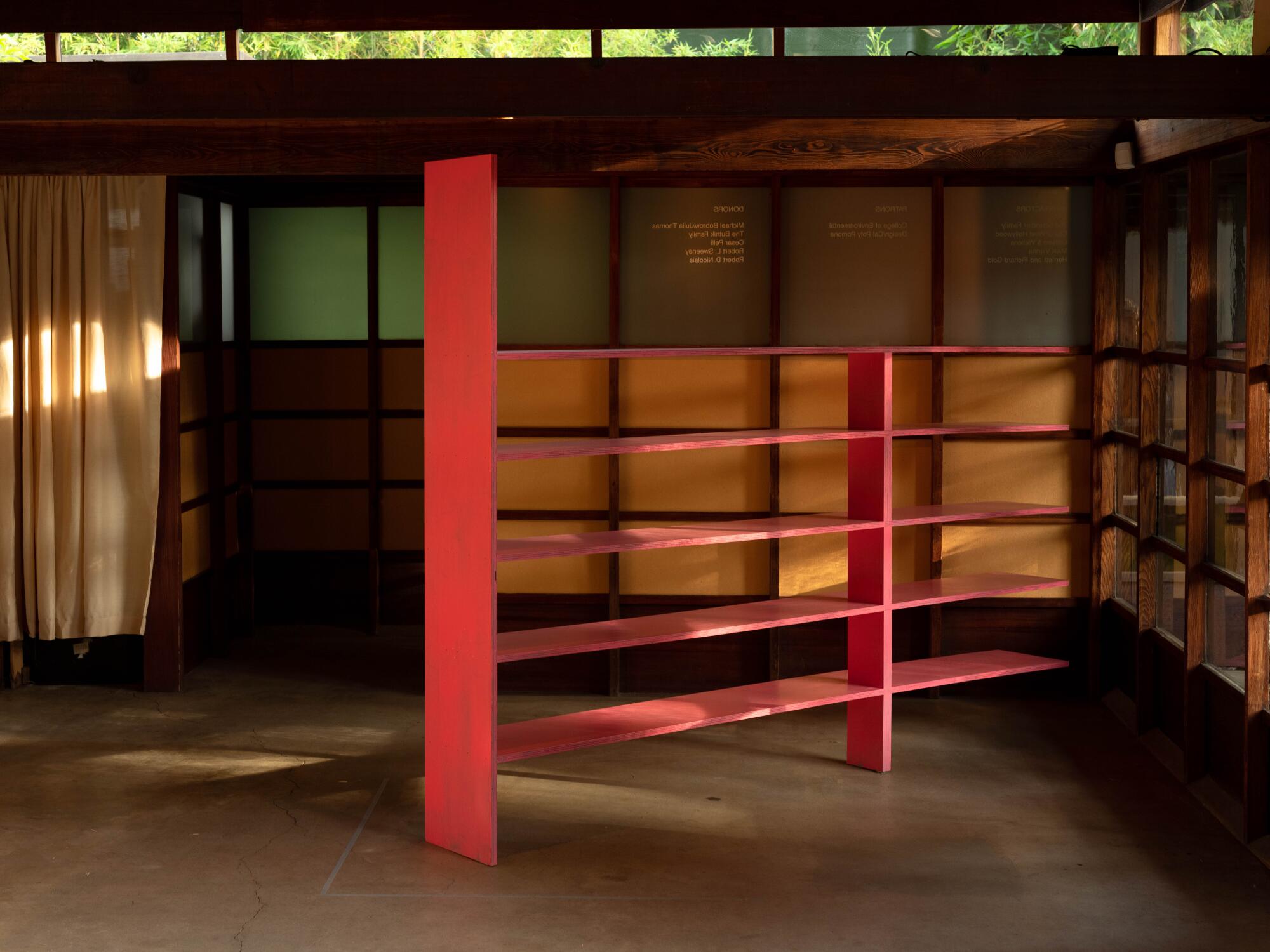
Review: History lurks in Stephen Prina’s sculptures at LACMA
April 21, 2013
It can be easy to wax romantic about Schindler and the ideas and artists that inspired his namesake house. He was a Viennese Modernist enamored with the allure of the Americas, where he arrived in 1914 and quickly absorbed his adoptive country’s wide-open spaces and homegrown traditions.
Schindler worked in Frank Lloyd Wright’s Chicago office before relocating to Los Angeles, where he oversaw construction of Wright’s hilltop home for heiress Aline Barnsdall (now known as the Hollyhock House ). On the drive west, he made a formative detour to Indigenous pueblos around Taos, N.M., which he later described as “the only buildings [in America] which testify to the deep feeling for soil on which they stand.”
These influences are mildly evident at the Schindler House, with its concrete slab walls that gently taper at the top, evoking the tilting contours of Indigenous adobes. (The show includes photographic images taken by Schindler during his sojourn in New Mexico.)
Schindler was influenced by Wright, but he hardly treated his ideas as gospel. Where Wright was formal and rigid, Schindler was anything but — both in his designs and in his person. In photos, he is often decked out in ensembles that evoke the look of a dapper Spanish peasant: white trousers, white shirt with splayed collar and hair coiffed into a snappy pompadour.
An even more direct inspiration was a camping trip to Yosemite: The home’s design includes outdoor sleeping porches on the second story, dubbed “sleeping baskets,” that were topped only by a sheet of canvas.
These structures are beautifully evoked in an ethereal courtyard pavilion — a structure of wood and billowing gauze — that was created for the exhibition by Austrian architect Jakob Sellaoui .

MAK’s exhibition smartly recasts some of these dreamy accounts, which elide some of L.A.’s uglier historical episodes.
The land on which the Schindler House sits was acquired in part from a judge and real estate developer who had served in the Confederate cavalry during the Civil War and regularly hosted events for the United Daughters of the Confederacy. When the plot was sold to Schindler, the deed included a covenant that prohibited the property from being “leased, sold, devised or conveyed to, or inherited by, or otherwise becoming the property of, any person other than of the Caucasian race.”
That deed and other enlightening historical documents have been re-created by artist Kathi Hofer and displayed on the walls and in vitrines around the house.
Along with related artworks, these help rewrite the narrative around the European Modernists working in Southern California — that L.A. offered them freedom and oodles of empty space in which to work out their ideas.
The space was never empty. It was, in fact, very fraught.

The exhibition is an opportunity to consider the forces that shaped the Schindler House. It’s also a chance to revel in the home’s aesthetic pleasures. One of the more beguiling installations is a luminous architectonic piece by Andrea Lenardin Madden inspired by the home’s slender vertical windows; it gives the illusion she has added additional windows to the space.
The centennial also marks a moment to consider the home itself.
The house is showing its age, with cracks running through floors and woodwork that is decaying. (Friends of the Schindler House has launched a $1-million campaign to get repairs done, of which it has raised about $100,000.)
Despite the wrinkles, Schindler’s concept remains relevant — something to draw from as L.A. finds itself in a housing crunch.
The house was conceived as a multifamily dwelling, designed so that the Schindlers could occupy a pair of studios on the southern side of the house while those on the north were turned over to the Chaces (and their successors). Between the studios lay a kitchen and a guest apartment.
The idea was that each individual — male and female — would have space in which to live and work and that the kitchen would be shared. It’s what we today would refer to as co-housing. It was also remarkably gender-egalitarian for the era.

Ultimately, the Schindler House is deeply of its place.
“I came to live and work in California,” Schindler wrote in the year before his death. “I camped under the open sky, in the redwoods, on the beach, the foothills, and the desert. I tested its adobe, its granite, and its sky. And out of a carefully built up conception of how the human being could grow roots in this soil — unique and delightful — I built my house. And unless I failed it should be as Californian as the Parthenon is Greek and the Forum Roman.”
It could exist nowhere but California. “Schindler House: 100 Years in the Making” is a thoughtful way to get reacquainted with the icon that quietly resides in our midst.
'Schindler House: 100 Years in the Making'
Where: Schindler House, 835 N. Kings Road, West Hollywood When: Through Sept. 25 Info: makcenter.org
More to Read
These 10 buildings tell the story of l.a.’s roaring 1920s, year by year.
July 30, 2024

Behind the privacy hedges and block walls stand L.A.’s notable and notorious homes
July 17, 2024

‘Concrete Architecture’ pictures magical forms made from the humblest of materials
July 10, 2024
The biggest entertainment stories
Get our big stories about Hollywood, film, television, music, arts, culture and more right in your inbox as soon as they publish.
You may occasionally receive promotional content from the Los Angeles Times.

Carolina A. Miranda is a former Los Angeles Times columnist who focused on art and design, with regular forays into other areas of culture, including performance, books and digital life.
More From the Los Angeles Times
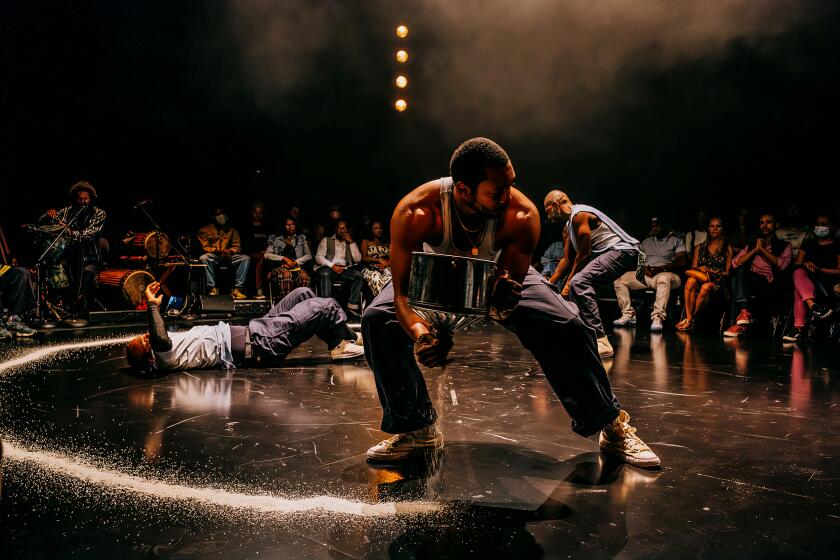
Review: The Tarell Alvin McCraney era begins at the Geffen with powerful ‘The Brothers Size’
Aug. 23, 2024

Watch Australian breakdancer Raygun bust her moves in the dark at this California mountain town

Travel & Experiences
9 under-the-radar things to do in Avalon, the iconic Catalina Island town

Review: Sasha Velour, winner of ‘RuPaul’s Drag Race,’ tells her own story in ‘Velour: A Drag Spectacular’
Aug. 20, 2024
By providing your information, you agree to our Terms of Use and our Privacy Policy . We use vendors that may also process your information to help provide our services.
CITY OF ANGLES: A SCHINDLER HOUSE TOUR
- Share on Facebook
- Show more sharing options
- Share on WhatsApp
- Print This Page
- Share on LinkedIn
- Share to Flipboard
- Submit to Reddit
- Post to Tumblr
If Neutra is the big-budget master, Schindler would be the indie innovator, creating cutting-edge quality on a shoestring. They are usually thought of as a pair—similarly educated Austrians whose friendship ended in a bitter rivalry. But a closer look shows them to be two very different architects responsible for two very different, if equally distinguished, bodies of work.
Schindler’s output stands in marked contrast to that of today’s architectural globe-trotters with building sites from Bangladesh to Brazil. Of his 500 projects, around 150 were realized, almost all of them located in the Greater Los Angeles area. “I came to live and work in California,” Schindler once stated. “Out of a carefully built-up conception of how the human being could grow roots in this soil, I built my house.” Eventually becoming a naturalized American citizen, he died in LA in 1953. He felt his work should be “as Californian as the Parthenon is Greek.”
After the ebb and flow of theoretical doctrines over the last 100 years, followers of architecture have embraced synthesized modernism on a mass level. The crisp, clean white box has become the purest symbol, the flag bearer of pure design. But after the symbolic white box, then what? In the absence of an architectural messiah, the public is driven to become more discerning in its appreciation of the century past—returning to classic modernism to find its unsung heroes. The focus has narrowed to the pivotal city of Los Angeles, with its history of architectural adventure and freedom. Figures like the late Franklin D. Israel and Michael Rotondi acknowledge Schindler’s influence, and the Gehry school’s use of basic readymade materials is considered to have a precedent in his work. It’s thus no accident that Schindler’s time has come. Nearly fifty years after his death, public groundswell has at last afforded him the superstardom he deserves.
— Barry Sloane

Most Popular
You may also like.

- west elm kids
- west elm business to business
- Pottery Barn
- Williams Sonoma
- Rejuvenation
- Mark & Graham
Earn 10% back in rewards with a new West Elm credit card →
See if you're pre-approved – Earn 10% in rewards 1 today with a West Elm credit card →
- Sign In / Create Account
- B2B Member Sign In
- Key Rewards
- West Elm Credit Card
- Favorites Click to view your favorite products. Favorites
The fall collection is here Shop new arrivals →
Up to 30% off outdoor & garden Shop in-stock outdoor →
Up to 50% off Shop all sale →
Going Global - Available in over 60 countries
We now offer international shipping through global provider, Borderfree. As you shop, you will see prices in your selected currency. You can change where you would like to ship your items in the top right corner of our website.
To learn more about international shipping, please visit our International Orders page.
You are currently shipping to
PLEASE NOTE:
Some items are not eligible for international shipping. Please look for eligibility notifications on our product pages, or view our guidelines to see which items are ineligible .
All international orders must have a ship-to destination outside of the United States. We cannot support customers with international billing addresses shipping to U.S. addresses.
Free Shipping promotions cannot be applied to International Orders.
You can view your complete order total, including shipping fees, custom tariffs and taxes, during checkout.
*We are sorry that we no longer ship to the Province of Quebec, Canada.
- Schindlers List Tour

Tour Information
Few wartime tales have captured the imagination as much as that of Oskar Schindler, the flamboyant Nazi businessman who rebelled against Hitler, rescuing over a thousand Jews from the death-camps. Catapulted to fame by author Thomas Keneally and film-maker Steven Spielberg, Schindler’s odyssey is now known across the globe. And as it was, the reality of Oskar Schindler’s life is every bit as extraordinary as the books and movies proclaim.
Remarkably, much of the world that Oskar Schindler knew in Krakow has survived intact. The Schindler Factory still stands, as does its owner’s wartime apartment and the eerie house that was the residence of Camp Kommandant Amon Goeth. Spielberg shot his movie ‘Schindler’s List’ here in Krakow, using many locations that Schindler knew intimately. Our tour combines insights into Spielberg’s film with historical details of the wartime occupation itself.
Much of Spielberg’s filming was done in Kazimierz, the historic Jewish district, but we will explore the actual wartime ghetto over the river in Podgorze. There, besides the faded nineteenth century housing blocks themselves, fragments of the Old Ghetto Wall survive, as does the infamous Plac Zgoda (Concorde Square – now named after heroes of the ghetto), where Tadeusz Pankiewicz’s pharmacy provided a lone sanctuary for the embattled Jewish population.
Prices and Group Bookings
Price depends on group size. Please fill in the booking form to receive your quote
* This tour can be combined with elements of the Jewish Kazimierz Tour.
What’s included in the price?
Private tour with English speaking guide; visit to Schindler Factory museum (entrance included), walk around the Kazimierz district.
Pickup 10am / return 1.30pm. Approx 3.5h tour

Schindlers List Tour Reviews

A place of remembrance

An unforgettable underground experience

A full day visiting Krakow's most important sites

It's not all wodka here!
Finding your way around a new city can either be a fun adventure or…
The famous salt mines of Krakow are located in the nearby town of Wieliczka, and a fascinating…
Krakow on a budget can be a truly enlightening experience. It can…
The first thing you need to know is that Auschwitz Concentration Camp is now a museum located in the…
- Polish Pierogi Classes
- Polish Cooking Classes
- Eat with Locals
- Hot Air Balloon
- Krakow City Bicycle Tour
- Krakow Country Bicycle Tour
- Communism & Nowa Huta Tour
- Communism & Nowa Huta Tour (Deluxe)
- Zakopane Tatra Madness
- Ojcow Valley Tour
- River rafting on Dunajec
- Auschwitz Tour
- Wieliczka Salt Mine Tour
- Auschwitz & Salt Mine Tour
- Polish Beer Brewery Tour
- Krakow Old Town Walking Tour
- Jewish Kazimierz Walking Tour


- Visit Our Blog about Russia to know more about Russian sights, history
- Check out our Russian cities and regions guides
- Follow us on Twitter and Facebook to better understand Russia
- Info about getting Russian visa , the main airports , how to rent an apartment
- Our Expert answers your questions about Russia, some tips about sending flowers

Russian regions
- Chelyabinsk oblast
- Khanty-Mansi okrug
- Nefteyugansk
- Nizhnevartovsk
- Kurgan oblast
- Sverdlovsk oblast
- Tyumen oblast
- Yamalo-Nenets okrug
- Map of Russia
- All cities and regions
- Blog about Russia
- News from Russia
- How to get a visa
- Flights to Russia
- Russian hotels
- Renting apartments
- Russian currency
- FIFA World Cup 2018
- Submit an article
- Flowers to Russia
- Ask our Expert
Khanty-Mansiysk city, Russia
The capital city of Khanty-Mansi okrug .
Khanty-Mansiysk - Overview
Khanty-Mansiysk is a city in Russia, the administrative center of the Khanty-Mansi Autonomous Okrug - Yugra. This is one of the oldest, most beautiful, and unusual cities in Western Siberia. Located on seven hills about 20 kilometers from the confluence of two great Siberian rivers - the Ob and Irtysh, it has a unique natural landscape.
The population of Khanty-Mansiysk is about 106,000 (2022), the area - 10.5 sq. km.
The phone code - +7 3467, the postal codes - 628000-628991.
Khanty-Mansiysk city flag
Khanty-mansiysk city coat of arms.
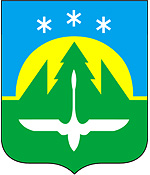
Khanty-Mansiysk city map, Russia
Khanty-mansiysk city latest news and posts from our blog:.
4 March, 2017 / Khanty-Mansiysk - the view from above .
6 March, 2011 / Khanty-Mansiysk - the capital of the world biathlon for two weeks .
22 November, 2010 / The handicrafts center of Khanty-Mansiysk city .
15 June, 2010 / Khanty-Mansiysk city puppet theater project pictures .
History of Khanty-Mansiysk
Khanty-mansiysk in the 16th-18th centuries.
In May 1582, the Cossacks began a “yasak campaign” (to exact fur tribute from the indigenous peoples of Siberia) along the Ob and Irtysh rivers, and didn’t meet any serious resistance on their way until Samar, the chief prince of the local Khanty (Ostyaks) people, decided to fight back and was killed. The settlement that existed in this territory was plundered and deserted. The full inclusion of Siberia in Russia took another half a century.
In the 1630s, people from other parts of Russia began to arrive in the lower Irtysh to service the postal tracts. In 1635, one of the first official documents was signed on the creation of Samarovsky settlement, which was named after the Khanty Prince of Samar killed here.
In the 17th century, its favorable location at the intersection of important routes allowed Samarovskaya sloboda (settlement) to become a center of trade. Merchants from all over the world brought cloth, velvet, silk, spices, jewelry to Siberia. Russian merchants offered fur, fish, hides, dishes, buttons, gunpowder. A branch of the Tobolsk Customs was opened here, where screening and evaluation of goods were carried out, duties were collected.
In 1708, Samarovo became part of the Siberian Governorate. In the 18th century, the residents of the settlement had to master crafts and production, since Eastern Siberia was joined to Russia and the main trade routes shifted south. The settlement began to be called Samarovo. In 1748, the population of the village was 487 people.
More Historical Facts…
Khanty-Mansiysk in the 19th-20th centuries
In the 19th century, Samarovo began to attract more and more attention from travelers, researchers, and scientists. Edmond Cotteau, a French traveler, wrote: “Samarovo is a beautiful settlement built at the foot of hills covered with dense forest. The church with white domes stands in the middle of it. Previously, the capital of the Ostyak kingdom stood here, but its original residents left it and settled in remote valleys. Now, the only residents here are Russians…”.
At the turn of the 19th-20th centuries, Samarovo became a prosperous village with numerous large two-story houses. In 1930, a decree was issued on the organization of the Ostyak-Vogul National District. In 1931, 5 km from Samarovo, construction of the new capital of the region began. It was named Ostyako-Vogulsk. In 1937, a road was built between the new village and Samarovo. Later, it began to be called “Khanty-Mansiysk Street”. In 1938, the population of Ostyako-Vogulsk was about 7.5 thousand people. In 1940, Ostyako-Vogulsk was renamed Khanty-Mansiysk.
In 1950, the village of Khanty-Mansiysk received the status of a town, the village of Samarovo became its part. In 1953, a natural gas field was discovered in the village of Berezovo located north of Khanty-Mansiysk. In 1960, oil was discovered in the Khanty-Mansi Autonomous Okrug. Khanty-Mansiysk began to grow and develop rapidly.
The airport was reconstructed, new apartment buildings, schools, kindergartens, libraries, and a cultural center were built. Thousands of people arrived to develop the oil region. In 1989, the population of Khanty-Mansiysk was about 34.5 thousand people.
The latest history of Khanty-Mansiysk
The beginning of the 1990s was a time of great changes for Khanty-Mansiysk. In 1993, the Khanty-Mansiysk Autonomous Okrug became a subject of the Russian Federation and received the right to independently form its own budget.
Significant funds began to be allocated for the development of the transport and communal infrastructure of the region, for the implementation of social programs aimed at improving the living conditions of the population, preserving the traditional culture of the indigenous peoples of the North.
In 1993, the IV International Folklore Festival of Finno-Ugric Peoples was held in Khanty-Mansiysk. In 1996, a federal highway connected the city with Surgut, Nefteyugansk, and Tyumen.
In 2004, a unique automobile bridge was built over the Irtysh River and the city received reliable communication with Nyagan and other cities of the western part of the Khanty-Mansi Autonomous Okrug - Yugra. In 2010, the road built through the village of Gornopravdinsk reduced the distance from Khanty-Mansiysk to Tyumen by 300 kilometers.
In the 2000s, the city as the center of the largest Russian oil and gas region developed rapidly, its population more than tripled. A number of educational and scientific centers, cultural and sports facilities were opened in Khanty-Mansiysk: the Khvoyny Urman ski complex, the Ice Sports Palace, the Ugra-Athletics open stadium for 10,000 spectators, the Center for the Development of Tennis Sports, the cultural tourist complex “Archeopark”, the equestrian club “Mustang”, Yugra Chess Academy, and others.
In June 2008, Khanty-Mansiysk hosted the World Congress of Finno-Ugric Peoples and the V International Festival of Finno-Ugric Peoples Crafts “Yugra-2008”. In September 2010, the 39th World Chess Olympiad was held in Khanty-Mansiysk. About 1.5 thousand chess players from 158 countries arrived here to participate in the most massive sporting event in the history of the city.
Pictures of Khanty-Mansiysk
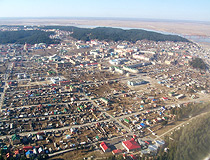
General view of Khanty-Mansiysk
Author: Sergov
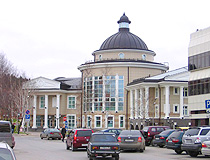
State Art Museum in Khanty-Mansiysk
Author: Igor Timoshok
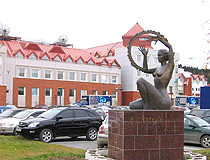
Sculpture of a woman with a tambourine in Khanty-Mansiysk
Khanty-Mansiysk - Features
Khanty-Mansiysk is located on the territory of the West Siberian Plain in the central part of Western Siberia, on the right bank of the Irtysh River, about 20 kilometers from the confluence with the Ob River; in the natural zone of the taiga. The distance to Tyumen is 669 km, to Moscow - about 2,580 km.
It is the largest of the centers of the autonomous regions of Russia and the only one with a population of more than 100,000 people. At the same time, it is one of the few Russian administrative centers, which is smaller than other cities of the region. Khanty-Mansiysk is only the fourth largest city of the Khanty-Mansi Autonomous Okrug after Surgut, Nizhnevartovsk, Nefteyugansk.
This city is equated to regions of the Far North and is located in the continental climate zone. The average temperature in January is minus 18.9 degrees Celsius, in July - plus 18.4 degrees Celsius.
In recent years, Khanty-Mansiysk has one of the highest, even by all-Russian standards, population growth rates. The annual growth is about three thousand people. Students and working youth make up more than 30% of its population. The average age of a city resident is about 35 years.
Khanty-Mansiysk is a green city. Almost a third of its territory is occupied by forest. The city is surrounded by Samarovsky Chugas Park - a natural reserve with relict species of conifers. The environmental situation in the city is very favorable, because there are no large industrial enterprises.
The airport of Khanty-Mansiysk offers regular flights to Moscow, Kazan, Novosibirsk, Yekaterinburg, Krasnoyarsk, Ufa. It is connected by road with other major cities of the Tyumen region (Surgut, Nefteyugansk, Tyumen).
Passenger ships connect Khanty-Mansiysk with a lot of towns and villages of the region, as well as with Tobolsk, Omsk, and Salekhard. The nearest railway stations are Pyt-Yakh (248 km from Khanty-Mansiysk) and Demyanka (238 km from Khanty-Mansiysk). The bus network of Khanty-Mansiysk is represented by 7 city and 1 country bus routes.
Khanty-Mansiysk is a center of skiing of world importance. Here, from the beginning of the 2000s, a modern biathlon center has been operating. In 2000, 2005, and from 2007 to 2016 (except for 2014), the stages of the Biathlon World Cup were held here.
The most interesting souvenirs you can bring from Khanty-Mansiysk are various leather and fur products, original Khanty tambourines, folk dolls and Khanty toys, beadwork, pine nuts, wicker products made from cedar roots and grass.
Main Attractions of Khanty-Mansiysk
Archeopark “Samarovsky Ostanets” - a cultural and tourist complex with sculptures of ancient animals and people. The main sight is the famous stone sculpture of 11 mammoths. In addition, there are sculptures of wolves and bison, lions, deer, bears, rhinos, and other animals from the Pleistocene. Obyezdnaya Street, 23.
Museum of Nature and Man - one of the oldest and most interesting museums in Khanty-Mansiysk. The collection of this museum numbers more than 120 thousand exhibits: various cultural and everyday objects of the Khanty and Mansi peoples, reconstructions and models of ancient buildings, skeletons and stuffed animals, expositions showing external and internal processes of the Earth. Mira Street, 11.
State Art Museum . The art collection of this museum consists of sections of icon painting, Russian painting, graphics, prints, arts and crafts, and sculpture. Here you can see the paintings of famous masters of Russian fine art: Rokotov, Tropinin, Repin, Aivazovsky, Surikov, Levitan, and other artists of the 18th-20th centuries. The section of old Russian art includes works of icon painting of the 15th-19th centuries. Mira Street, 2.
Museum of Geology, Oil and Natural Gas . Khanty-Mansiysk is considered the heart of the natural gas and oil industry in Russia. The largest oil and gas fields in the country are located in this region. The collection is based on historical documents and photographs, precious stones, minerals and rocks, samples of oil production equipment, and decorative items. Chekhova Street, 9.
House-Museum of the People’s Artist of the USSR Vladimir Igoshev . The purpose of the museum is to popularize the works of the artist, who depicted in his paintings the beauty of the Siberian land, its history and culture, and the people living in Yugra. In addition to the exhibition halls, you can also visit the artist’s workshop and apartment. The appearance of the building constructed in the Russian Art Nouveau style with mosaics and stucco moldings is also interesting. Lopareva Street, 7.
Ethnographic open-air museum “Torum-Maa” . Located in the picturesque forest of the Siberian taiga, this museum preserves the culture and traditions of the Khanty and Mansi peoples. Here you can see the constructions of the indigenous inhabitants of this land, their household items, clothes, jewelry, and various collections of old objects. Traditional festivals and ceremonies are also held here. The name of the museum means “Holy Land”. Sobyanina Street, 1.
Orthodox complex “In the Name of the Resurrection of Christ” . Its majestic buildings, crowned with gilded domes, can be seen from almost any part of Khanty-Mansiysk. Built in 2005, the complex includes more than 10 buildings, the main of which are the Cathedral of the Resurrection, an Orthodox gymnasium and a school, the Church of Prince Vladimir, and a 62-meter bell tower, which is one of the tallest buildings in the city.
Here you can also find the first in Russia Orthodox park of Slavic writing and culture “Slavic Square” decorated with sculptures on the theme of the Ten Commandments. In addition, the complex has monuments to saints, alleys, playgrounds, and places for recreation. Gagarina Street, 9.
Monument to the Discoverers of the Yugra Land - a picturesque 62-meter trihedral pyramid lined with glass. Each side symbolizes an important milestone in the history of Yugra - the appearance of indigenious peoples, the exploration of the region by the Cossacks of Ermak, and the discovery of oil and natural gas fields. The pyramid is visible from anywhere in Khanty-Mansiysk as it is located on the slope of a high hill surrounded by forest. Pervootkryvateley Lane, 1.
The Red Dragon Bridge over the Irtysh River - one of the most beautiful bridges not only in Western Siberia, but also in Russia. The 1,316-meter-long bridge was built in 2004. It connects Khanty-Mansiysk with the western part of the Khanty-Mansi Autonomous Okrug.
Samarovsky Chugas Nature Park - a great place for ecotourism lovers. Spread along the picturesque hills, Samarovsky Chugas covers an area of ??more than 6.5 thousand hectares with dense forests, streams, and blue lakes. This park, once called the Khanty-Mansiysk Hills, has the status of a natural monument. This is a favorite place for lovers of wildlife and walks in the fresh air. The visitors of the park are also offered ecological sightseeing routes with an experienced tour guide.
Khanty-Mansiysk city of Russia photos
Sights of khanty-mansiysk.
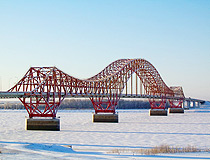
The Red Dragon Bridge in Khanty-Mansiysk
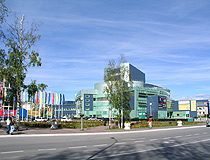
Yugra-Klassik concert hall in Khanty-Mansiysk
Author: Mariusz Rzetala
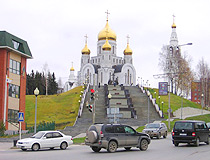
Cathedral of the Resurrection in Khanty-Mansiysk
Architecture of Khanty-Mansiysk
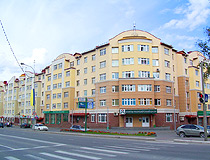
Apartment buildings in Khanty-Mansiysk
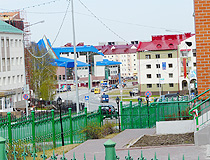
Khanty-Mansiysk cityscape
Author: Dmitry Sanatov
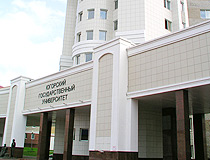
Yugra State University in Khanty-Mansiysk
The questions of our visitors
- Currently 2.90/5
Rating: 2.9 /5 (129 votes cast)
- Bahasa Indonesia
- Slovenščina
- Science & Tech
- Russian Kitchen
Khanty-Mansiysk: Why you simply must visit this northern land of mammoths
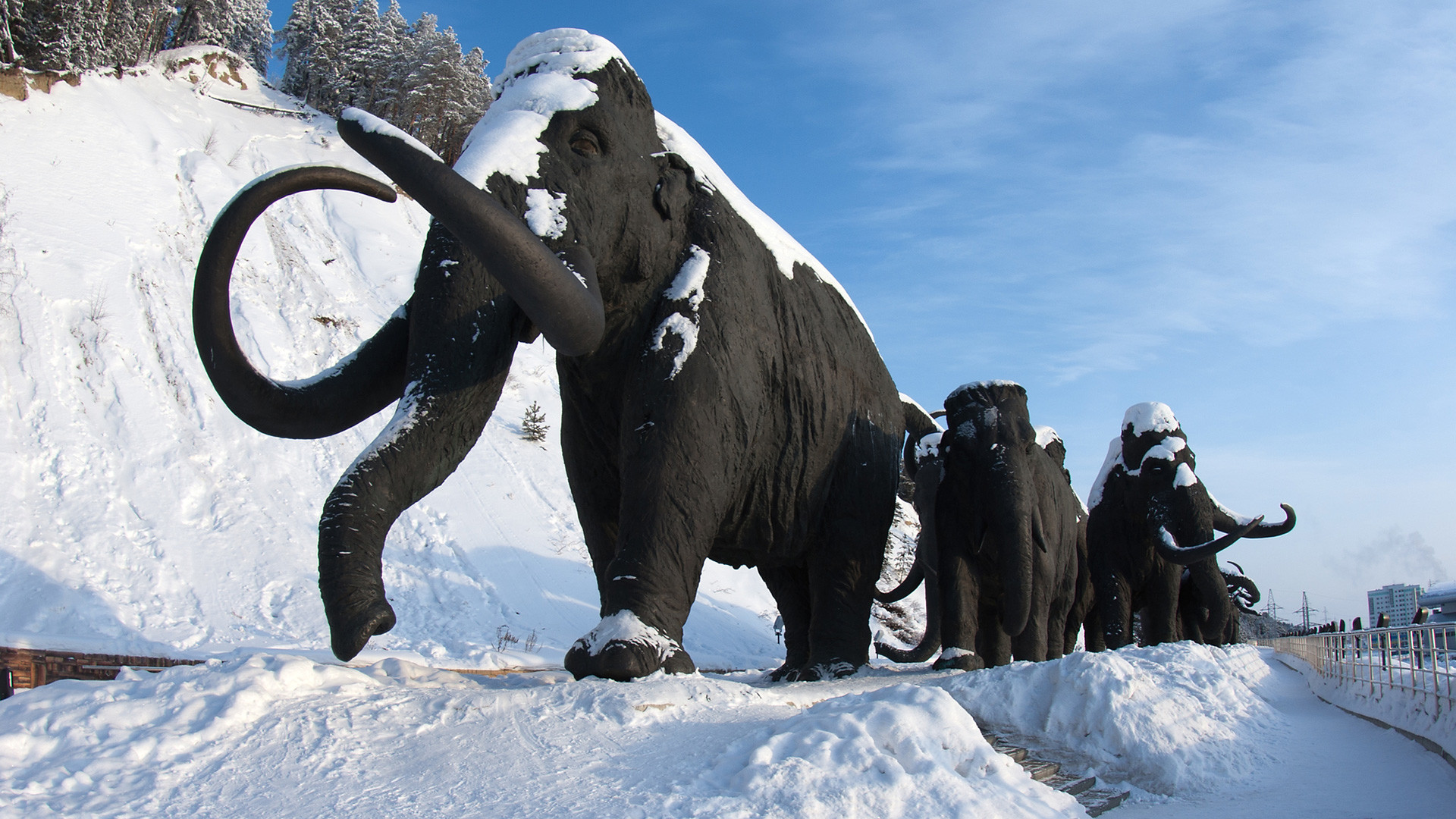
“I have been to Yugra many times. I was sworn in as a Siberian in a cedar forest,” producer Andrey Suleikov writes in the preface to a collection of legends called Yugra. It’s My Land . “I tasted lingonberries in the cold and could not tell whether the berries were coated in sugar or ice. I also enjoyed outdoor hot springs while taking a traditional Siberian bath."

Fuel pumping stations
Sounds more like time travel than a present-day tourist trip, doesn’t it? But that is what Yugra is like: a fusion between prehistoric things like mammoths and modernity, which has brought oil, gas and new buildings. Even the region’s official name (which is quite long: the Khanty-Mansi Autonomous Area – Yugra) combines the present with the past.
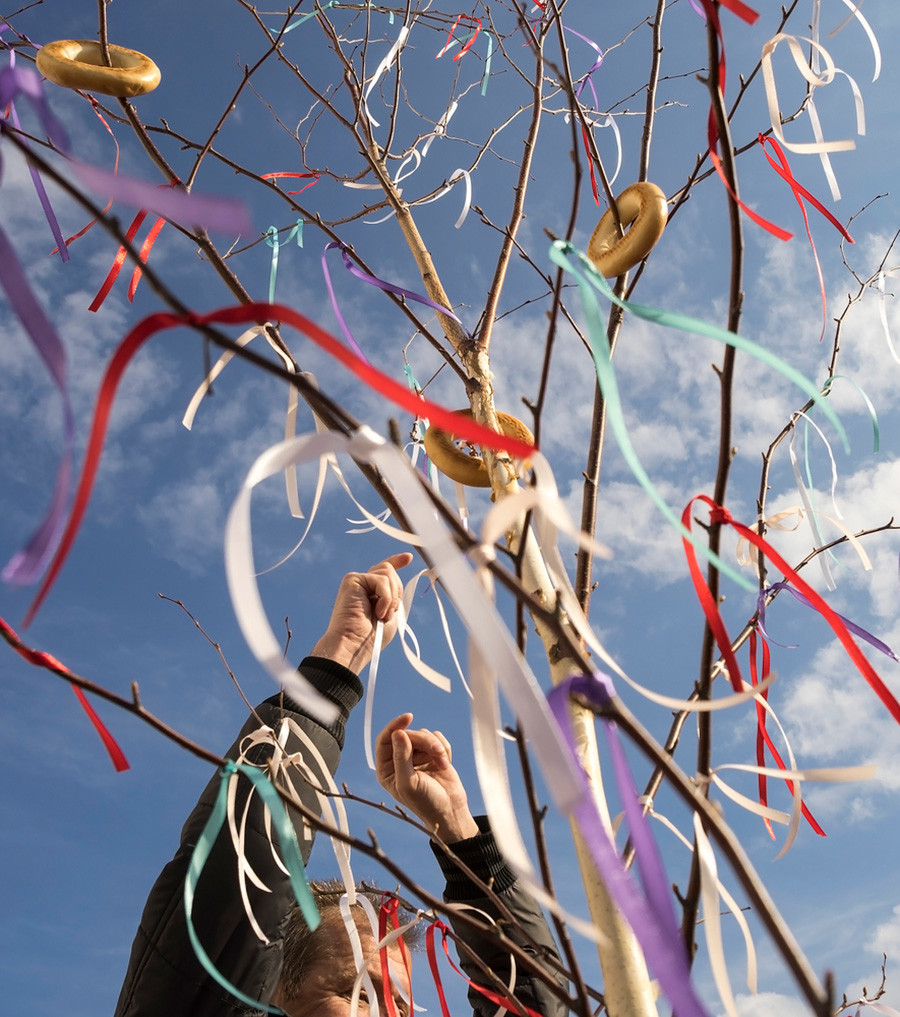
Tying a ribbon is a national tradition
There is a beautiful legend about Yugra’s origins. In one very bright, warm and sunny city, twins of unprecedented beauty were born: a brother named Yug and a sister named Ra. At first, they grew up like ordinary small children, but with age they began to argue and fight, so much so that when they did flames flared up around them. The townspeople were afraid that they would burn everything down, so they exiled Yug and Ra to a remote northern land covered with ice and snow. The brother and sister illuminated this land with their light and made it warm so that people could come here to live. Yug and Ra stopped fighting and began living together in harmony. Since then, this northern land has been called Yugra.
When you look at the map, it may seem that Khanty-Mansiysk is located almost in the middle of Russia. However, the climate here is similar to regions of the Far North. In winter, the temperature here drops to below -40 degrees Celsius.
We asked local residents and people who know this region well to tell us more about it and to share some tips for tourists who come to visit.
Why should a foreigner visit Khanty-Mansiysk?
“If you want to feel the coldness and colors of Russian winter, then you should definitely stop by in our small cozy town,” says a local tattoo artist, Semyon Chepurnoy.
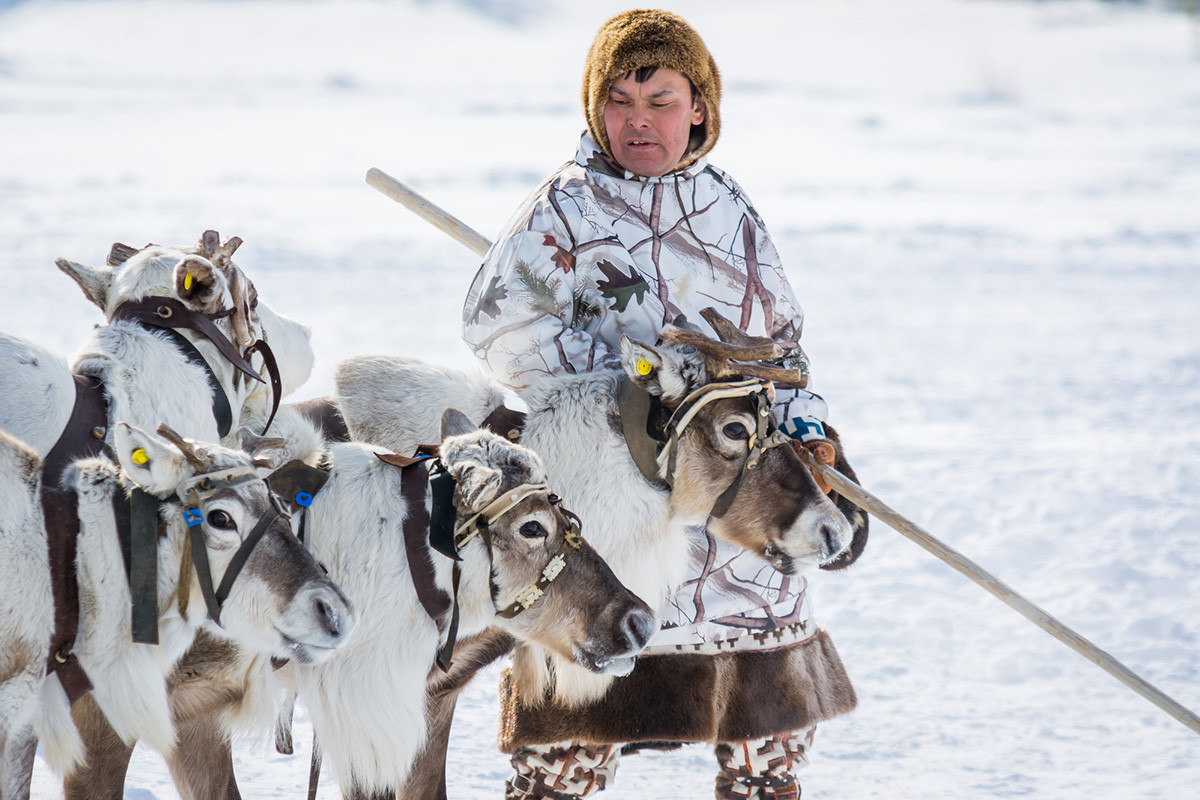
A Khanty man in a traditional dress
Yevgeny Zinovyev, a journalist and the former editor-in-chief of a local media outlet, says that Khanty-Mansiysk provides the opportunity to experience a real and not touristy part of Russia. “In winter, there are frosts, snowdrifts and wind. In summer, heat, midges and bears. At any time of the year, you can experience the everyday life and customs of the indigenous peoples: the Khanty and Mansi. And of course, in Khanty-Mansiysk you can get to know the backbone of modern Russia – its oil and gas sector."
“We have unique scenery here. Khanty-Mansiysk is located on seven hills and is surrounded by the taiga. There are a lot of fish in the rivers, and a lot of mushrooms, berries and pine nuts in the forests surrounding the city,” says local insurance company employee Sergey Yankovich.

View of the city and the Irtysh River
The harsh climate of the region influences how local residents relate to visitors. “Residents of the city are very good-natured and welcoming and are always ready to offer help in any situation, even to a stranger, because in the north, there is an unspoken rule: If you see that a person is in distress, be sure to help them, because tomorrow, it may be you in their place. The harsh climate and surrounding scenery leave no room for error, especially in winter,” Sergey says.
Things to see/do/taste in Khanty-Mansiysk
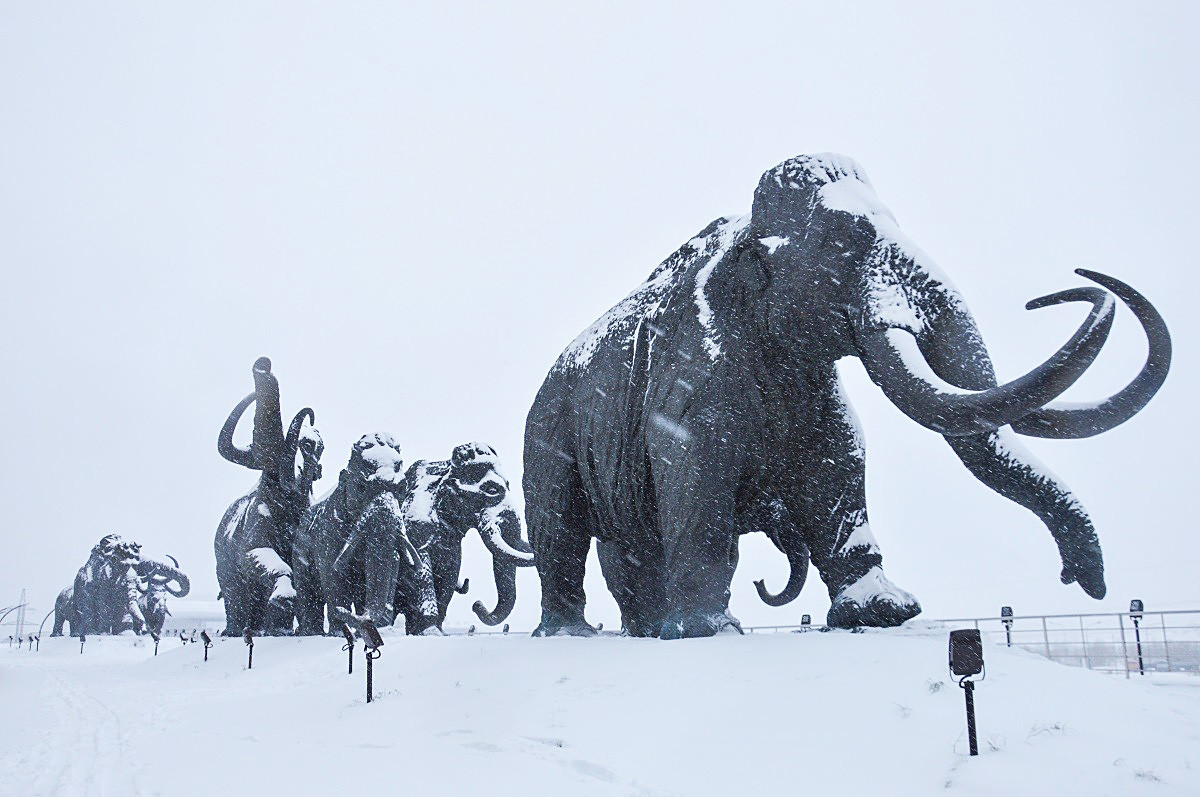
Mammoths at the Archeopark
According to Irina Pudova, a local resident and the author of a collection of legends called Yugra: It’s My land , the first thing to do in Khanty-Mansiysk is to see the local mammoths. Seven life-size bronze prehistoric animals "roam" the area near Samarovsky Hill on the grounds of the Archeopark complex. Here you will also find a prehistoric bison, a pack of wolves, a cave bear, two woolly rhinos and prehistoric people themselves.
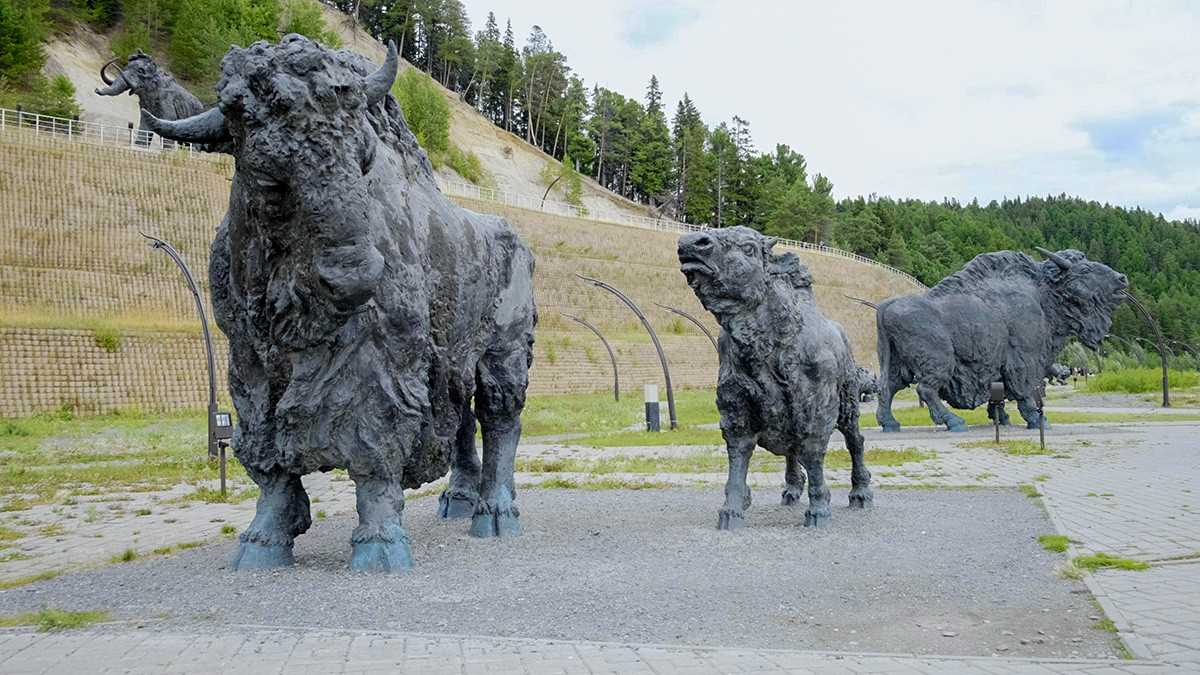
Sculptures of bisons at the Archeopark cultural and tourist complex
“Then you could get something to eat,” Irina advises. “The thing to do is to go to any local restaurant of Siberian cuisine and ask for muksun. It is a valuable freshwater fish of the salmon family, which is highly prized by locals and tourists alike.”
Khanty-Mansiysk is a relatively new city and only received this status in 1950. Soo oil was discovered in the region, prompting a dramatic push in its development. Prior to that, there were just Siberian settlements built by Russia in the late 16th century. Irina is impressed that a modern city was built in such harsh conditions.
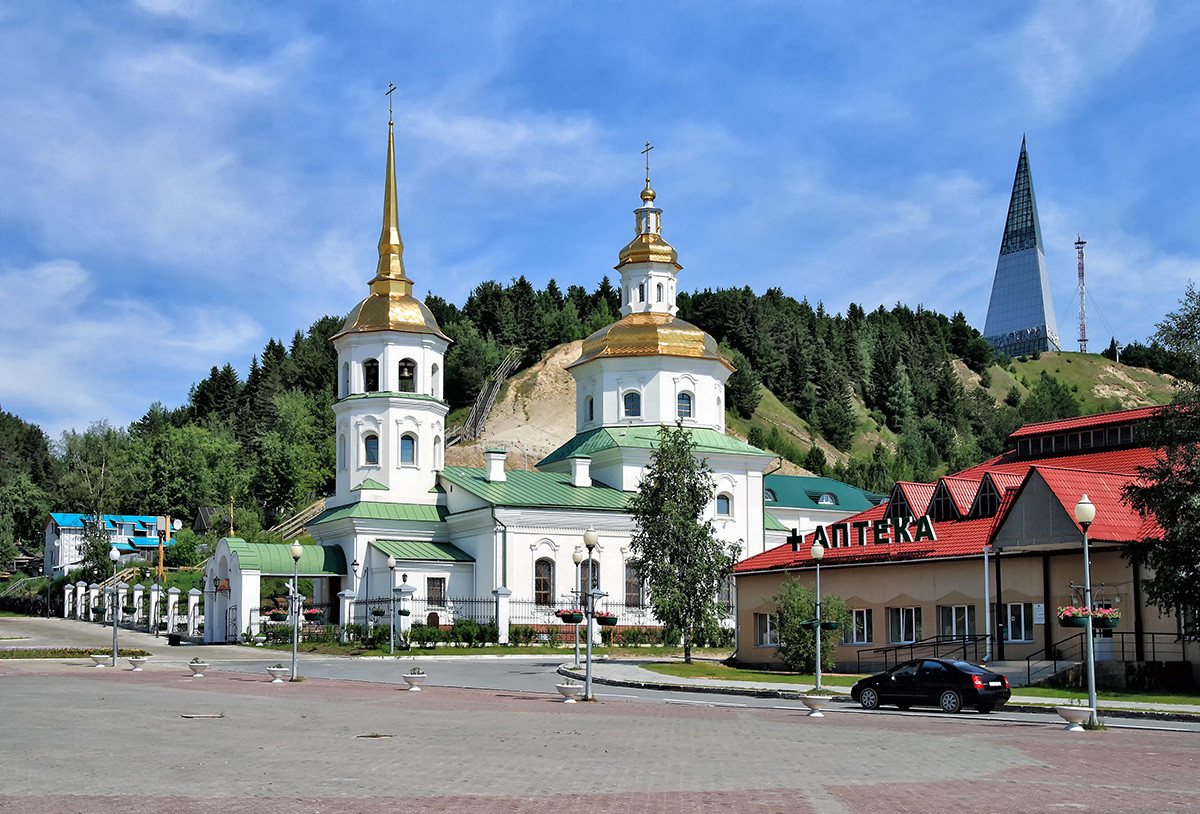
The Church of the Protection of the Holy Virgin
“Cultural objects, squares, houses - all this is unique. And everything is new, there is nothing very ancient here. Except for mammoths!” she says.
In addition to the Archeopark mentioned above, Yevgeny Zinovyev’s list of favorite places in the city includes the Museum of Geology, Oil and Gas, along with the Museum of Nature and Man and the centuries-old cedars in the Samarovsky Chugas natural park. He recommends checking out the views from the observation deck near the Monument to the Explorers of the Yugra Land and paying a visit to a local bathhouse.
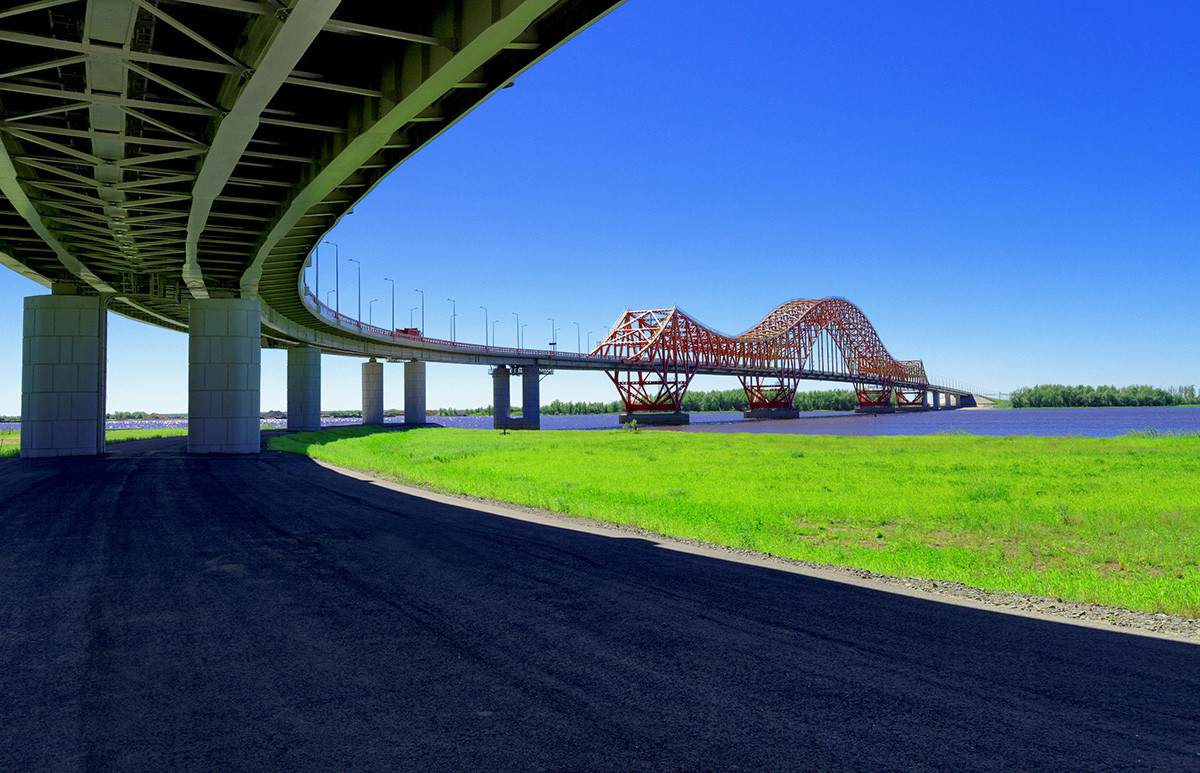
'Red Dragon' bridge over the Irtysh River
Yevgeny also provided us a checklist of culinary delights that anyone visiting Khanty-Mansiysk should be sure to try:
- Muksun (in any form but best of all frozen and sliced as Stroganina).
- Wild berries (cranberry, cowberry, cloudberry).
- Venison (in any form but best of all stewed and sprinkled with frozen berries and pine nuts).
Sergey Yankovich recommends visiting the open-air ethnographic museum Torum Maa, which means "Sacred Land" in Mansi. “There you can get acquainted with the history of the city and the district, as well as with the life of the indigenous peoples of the Khanty and Mansi, who belong to the Finno-Ugric group,” Sergey says.

Torum Maa ethnic center
In addition, he advises anyone who comes to Khanty-Mansiysk to visit the spot where the Ob and Irtysh rivers meet, pay a visit to Misne Hotel’s restaurant and taste traditional dishes there, as well as dishes prepared by local fishermen and hunters while in the taiga.
According to Semyon Chepurnoy, the Valley of Streams natural park is another must for any visitor. It is one of local residents’ favorite recreation areas, where you can stroll along a dedicated footpath offering stunning views of the city. Semyon also advises trying pancakes at the GoodFood chain of cafes.
What are the best souvenirs?
“We all love something mystical and supernatural. There is a strong culture of shamanism here, so I think it’s cool to take with you some local amulets charged by a shaman—a bear claw or a pendant made of beads and deerskin,” says Irina Pudova.
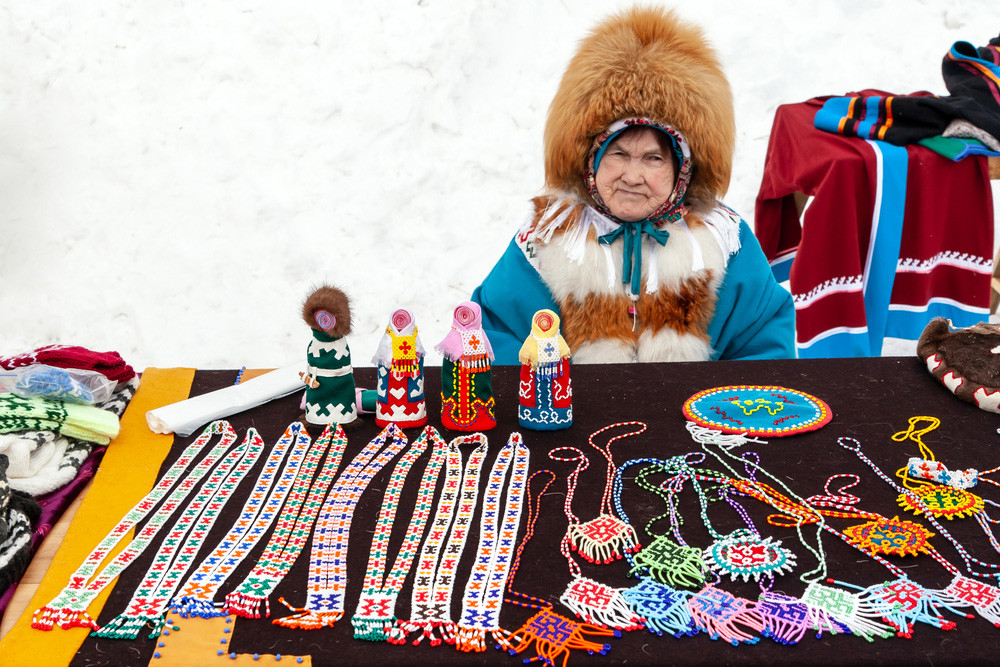
A Khanty woman in the traditional dress selling souvenirs
Sergey Yankovich advises that authentic souvenirs can be found at the Crafts Center on Roznina Street. “There you can also see and even try on the national costumes of the Khanty and Mansi and try to solve traditional puzzles that representatives of the indigenous peoples made for their children.”
According to Yevgeny Zinovyev, the best souvenirs are Khanty and Mansi amulets, clothes, jewelry, as well as traditional local treats such as muksun, wild berries, pine nuts and venison.
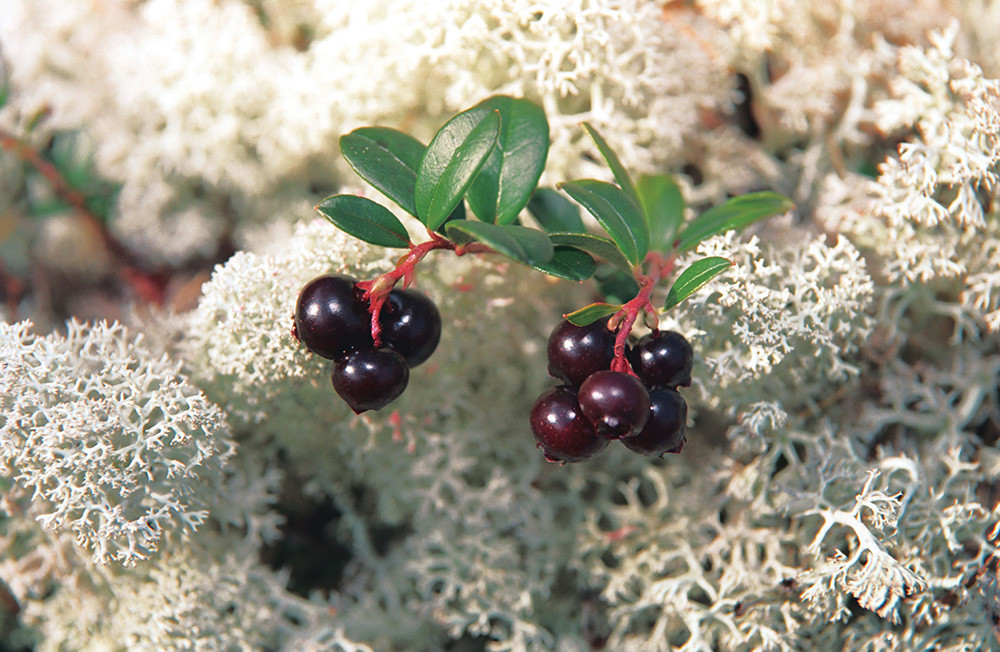
Cowberry bush
For his part, Semyon Chepurnoy recommends bringing away memories and photographs as well as a little bit of Siberian Frost ❄.
If using any of Russia Beyond's content, partly or in full, always provide an active hyperlink to the original material.
to our newsletter!
Get the week's best stories straight to your inbox
- 10 main stops on the Trans-Siberian Railway
- Naryan-Mar: Why you should visit this remote Arctic city
- An expat’s confession: Why I miss the city by the Amur – Khabarovsk
This website uses cookies. Click here to find out more.

Share ×

Scan the QR code and open PeakVisor on your phone
❤ Wishlist ×
See all region register, peakvisor app, khanty-mansiysk autonomous okrug – ugra.
Welcome to the land of sheer silent whiteness. Its vast expanses are filled with fresh Arctic air, howling winds, and the spirit of true adventure. Come with us to the lands of the ancient Khanty and Mansi tribes that survived in this harsh climate of the Nether-Polar Urals . See the mountains that defy any logical or geological reason for their existence. Experience the wonders of this sparsely populated land where you can hardly see a human trace. Welcome to Yugra!
Flora & Fauna
Water resources, landmarks and tourism, major mountains, mount narodnaya, mount zaschita, mount neroyka, the pyramid mountain, samarovskaya mountain, ski and sports facilities, protected sites, reserves, national and natural parks, rivers and lakes, major cities, khanty-mansiysk.
The Khanty-Mansiysk Autonomous Area – Yugra (KhMAO) is located in the central part of the West Siberian Plain, stretching from west to east from the Ural Range to the Ob-Yenisei Watershed. The vast areas of this plain, as well as the Lower Priob region, are considered one of the most recently inhabited areas.
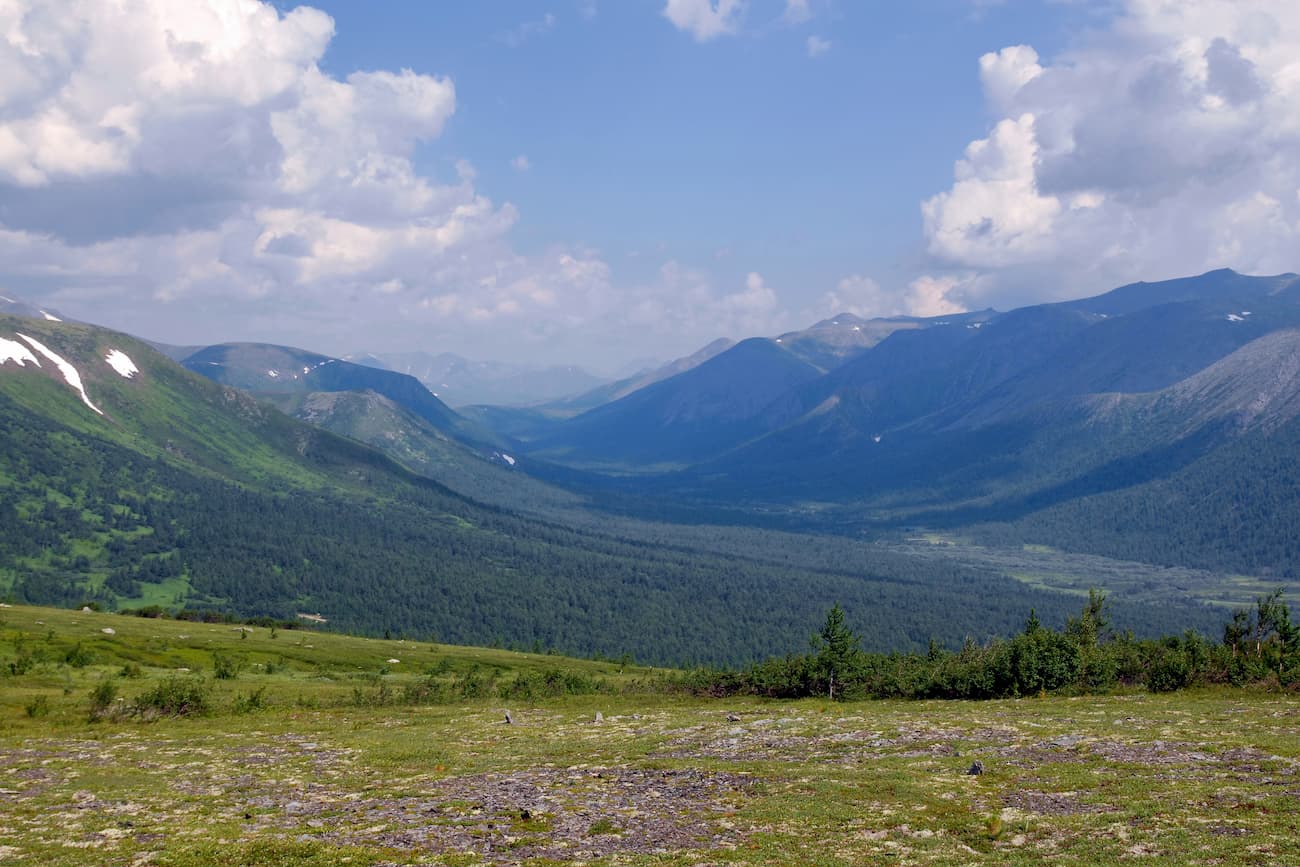
The Khanty-Mansiysk Autonomous Area (KhMAO) was established in 1930. Its name comes from two main northern indigenous peoples – the Khanty and the Mansi. From 1944 it was legally part of the Tyumen Region , but in 1993 the Area received autonomy and became a full-fledged territorial entity of the Russian Federation. It is a part of the Urals Federal District. The administrative centre is the city of Khanty-Mansiysk , whereas the largest city is Surgut. The word Yugra was introduced to the name of the Khanty-Mansiysk Autonomous Area in 2003 to pay tribute to the old name used by the locals to call the territories lying beyond the North Urals.
The KhMAO borders the Komi Republic in the north-west, the Yamalo-Nenets Autonomous District in the north, the Krasnoyarsk Area and the Tomsk Region in the east and south-east, the Tyumen Region in the south and the Sverdlovsk Region in the south-west.
The area of the territory is 534,801 sq.km, the length from north to south is 800 km, from west to east is 1400 km. The population of this huge territory is 1,674,676 people as of 2020, which is the same amount as people living in Barcelona or Munich.
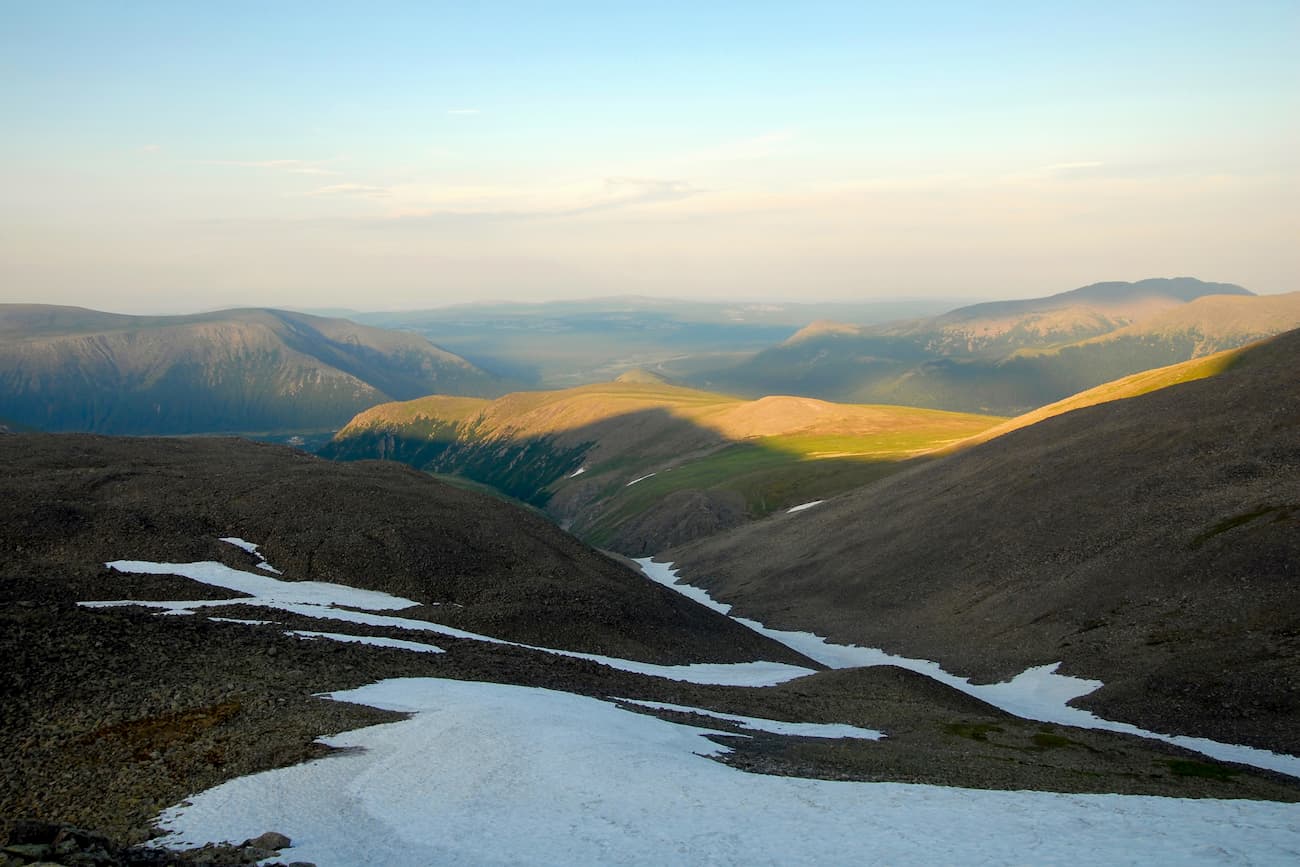
The main part of the territory is a huge, poorly dissected plain where absolute elevation marks rarely exceed 200 meters above sea level. The western part of the KhMAO territory is characterized by low and middle mountainous terrains with some Alpine relief featured in the Subpolar Urals. Here are ridges and spurs of the mountain system of the North Urals and the Subpolar Urals. The maximum absolute elevations are on the border with the Komi Republic . Mount Narodnaya (1,895m) is the highest peak.
More than 800 species of higher plants grow in the Khanty-Mansi Autonomous Area . Almost the entire territory is covered by taiga forests that occupy about 52% of the area. Spruce, fir, pine, cedar, larch, birch, alder grow here. In the northern parts of the area, the composition of the vegetation is greatly influenced by perennial permafrost. Light lichen grasslands which are used as deer pastures are widespread there. Tundra dominates in the mountainous and hilly areas. River floodplains and lowlands are characterized by meadow vegetation, the so-called water meadows. High floodplains of large rivers are mainly covered with woods that mainly feature willows, birches and aspens. Forests and swamps are rich in berries and various valuable plants, most of which are used in traditional indigenous medicine.
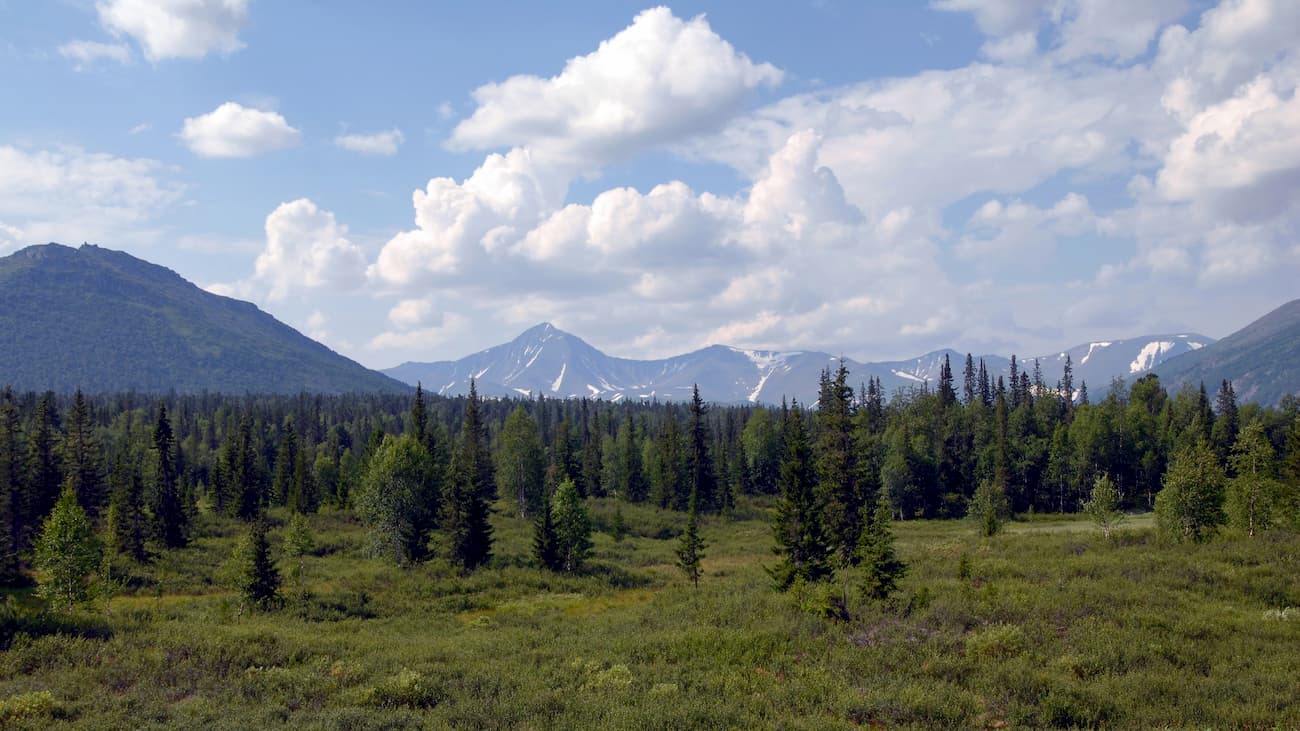
The animal world is typical for the Russian taiga zone. There are 369 species of vertebrates. Mammals are represented by 60 species (28 of them are commercial species). The most common and valuable of them are wild reindeer, elk, fox, sable, fox, squirrel, marten, ermine, Siberian weasel, polecat, mink, weasel, otter, hare and others. Wolverine and West Siberian river beaver are included in the Red Book of Russia.
There are 256 bird species in the region, including 206 sedentary and nesting species. Some rare bird species are listed in the Red Book. There are 42 species of fish in rivers and lakes. Of these, 19 species are commercial, among them are starlet sturgeon, lelema, muksun (whitefish), pelyad, chir, lake herring, wader, tugun, freshwater cod, pike, ide, roach, bream, fir, perch, ruff, golden and silver crucian carp, carp (carp is grown in the cooling ponds of the Surgutskaya and Nizhnevartovskaya hydroelectric plants). Sturgeon is listed in the Red Book. There is an abundance of mosquitoes and gnats in the area, the greatest activity of which is in the second half of summer.
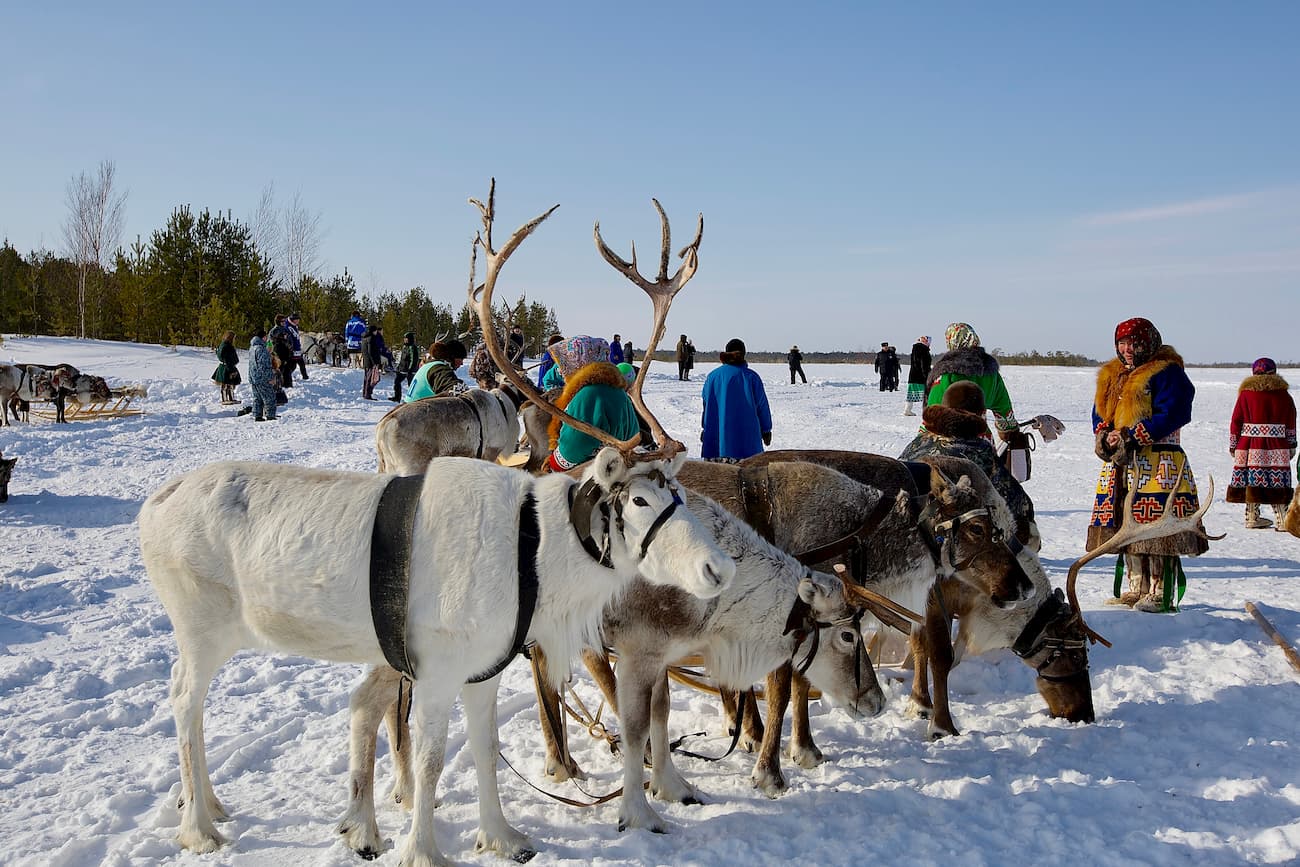
Yugra can boast of over 2 thousand large and small rivers, the total length of which is 172,000 km. The main rivers are the Ob (3,650 km), the Irtysh (3,580 km). These are some of the largest rivers in Russia. Other significant rivers include the tributaries of the Ob (the Vakh, Agan, Tromyogan, Bolshoy Yugan, Lyamin, Pim, Bolshoy Salym, Nazym, Severnaya Sosva, Kazym rivers), the tributary of the Irtysh (the Konda River) and the Sogom River. Ten rivers are over 500 km long. All the Yugra rivers with the exception of the rivers in the Ural part of the region are characterized by rather slow currents, gentle slopes, some surge wave phenomena, spring and summer floods. The Ob River basin extends over a distance of 700-200 km from the mouths of its tributaries. Such abundance of water facilitates the appearance of floodplain swamps and seasonal lakes.
The region's swamps are predominantly of the upper and transitional type. Those water basins occupy about a third of the region. About 290,000 lakes with the area of more than 1 ha are surrounded by swamps and forests. The largest lakes are Tursuntsky Tuman, Levushinsky Tuman, Vandemtor and Trmemtor. The deepest lakes are Kintus (48 m) and Syrky Sor (42 m). However, most of the lakes (about 90%) are modest and quite small and have no surface runoff.
The area is rich in resources of fresh, mineral and thermal underground waters, which are still insignificantly used.
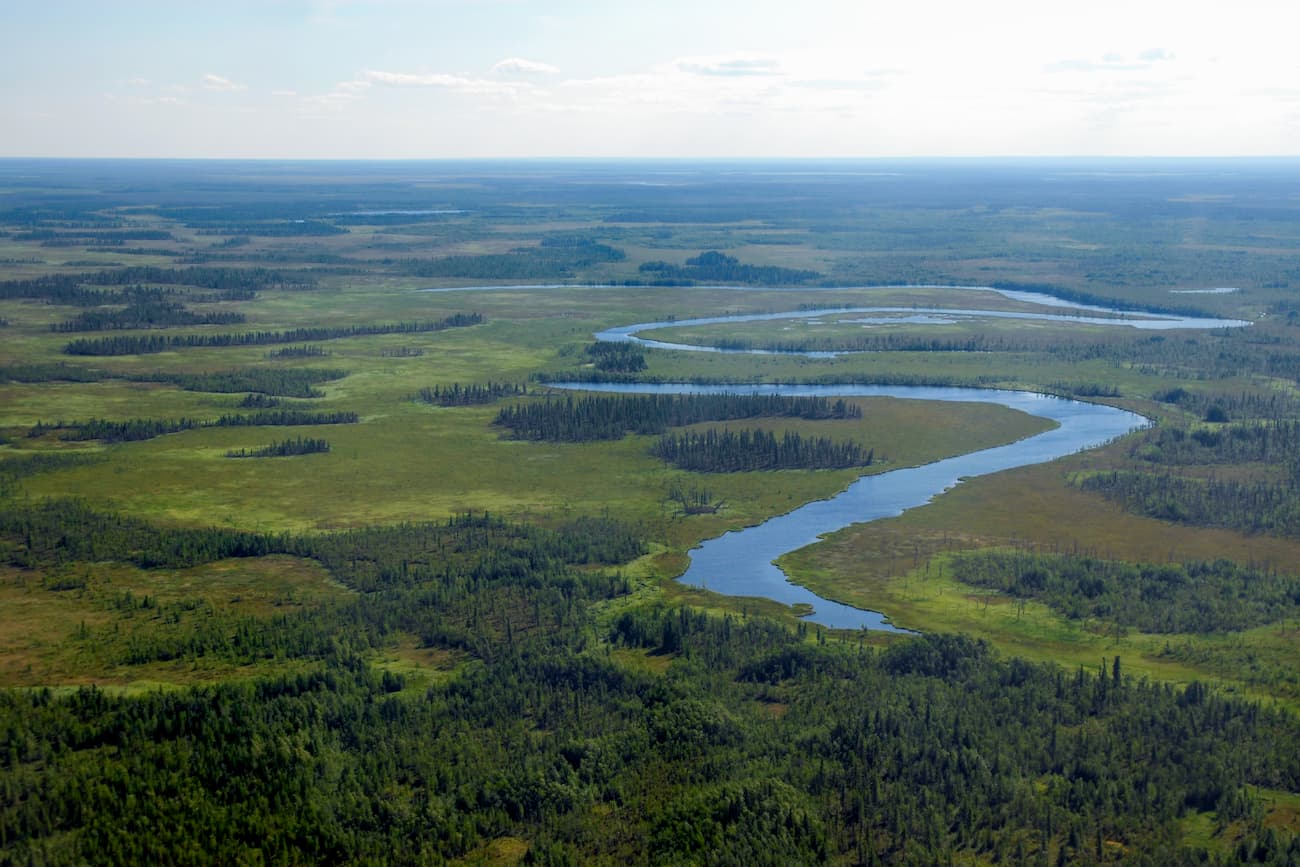
The climate is moderately continental. Winters are harsh, snowy and long, and summers are short and relatively warm. The territory is protected from the west by the Ural Mountains but its openness from the north has a significant impact on the climate formation because cold air masses from the Arctic freely penetrate the area. The flat character of the terrain with a large number of rivers, lakes and swamps also has its impact. Most of the precipitation falls during the warm seasons. But even with a small amount of precipitation, their evaporation is very low, which as a result contributes to the formation of the zone of excessive moisture throughout the Yugra. The snow cover is stable from late October to early May, its height varies from 50 to 80 cm. The region is characterized by a rapid change of weather conditions, especially in transitional seasons (autumn and spring), as well as during the day. Late spring and early autumn frosts are rather frequent and can happen even until mid-June. Average January temperatures range from -18ºC to -24ºC (0 F to -11 F) and can reach -60ºC to -62ºC (-76 F to -80 F) when the northern cold air masses break through. The average temperature in July, the warmest month of the year, ranges from +15ºC to +20ºC (+59 F to +68 F) and on very rare days can reach a maximum temperature of +36ºC (+97 F). The prevailing wind direction is north in summer and south in winter.
The weather in the mountains is quite changeable and cool even in summer. The best time to visit the region's mountains is between July and mid-August.
The Yugra of the Khanty-Mansi Autonomous Area has a huge natural resource potential. These are oil and gas deposits, forests, gold and iron ore deposits, as well as bauxites, copper, zinc, lead, niobium, tantalum, brown and hard coal deposits, rock crystal, quartz and piezo quartz, peat deposits, etc. The region has plenty of natural resources. In terms of natural gas reserves, the Yugra ranks second in the Russian Federation after the Yamalo-Nenets Autonomous District .
The industry is dominated by oil and gas production, power generation and processing industries, including woodworking except for pulp and paper production.

The Khanty-Mansi area has very developed tourism of all kinds. There is a modern infrastructure for cultural exploration as well as for active recreation.
Fans of sports and eco-friendly tourism will be able to conquer majestic mountains and raft down picturesque rivers, enjoy the beauty of nature in nature reserves and natural parks. The hills and mountains of this area open up endless opportunities for skiing and snowboarding.
The mountainous part of the Subpolar Urals located on the territory of the Khanty-Mansi Autonomous Area is very beautiful. The highest peaks of the Ural Mountains are situated here.
Being the highest point of the whole Urals, Mount Narodnaya (1,895 m), also known as Naroda and Poenurr and translated as People's Mountain is territorially situated in the Subpolar Urals, on the border of the Yugra Area and the Komi Republic . It is the highest point in European Russia outside the Caucasus. This leads to its large topographic prominence of 1,772 metres (5,814 ft).
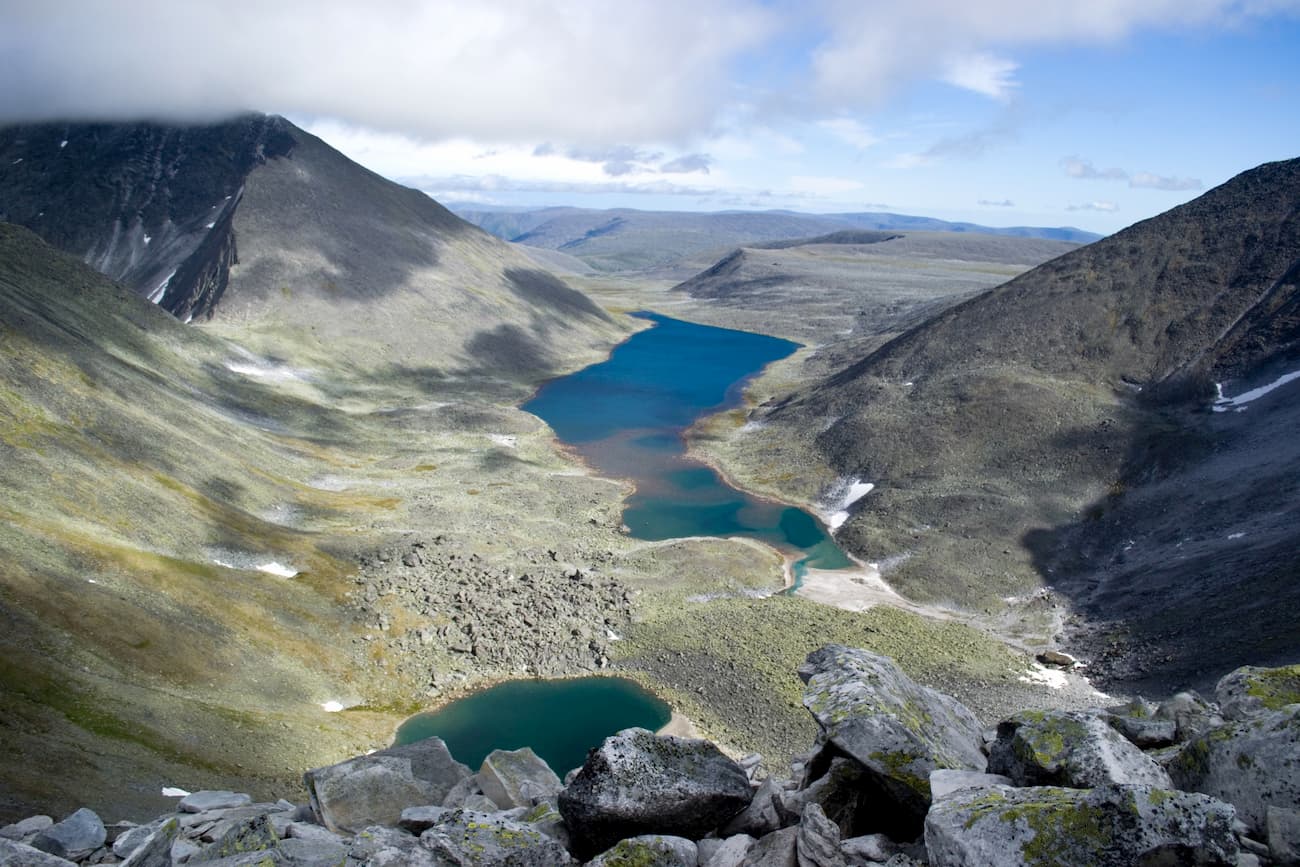
The top of the mountain is half a kilometre from the border towards Yugra. As for the name of the mountain, scientists could not come to a common opinion for a long time, so there are two versions. According to one version, in the Soviet years, an expedition of pioneers gave the mountain a name in honour of the Soviet people - Narodnaya (the stress is on the second syllable). According to the other version, even before the arrival of the first Soviet tourists, the peak was named after the River Naroda (the stress is on the first syllable) flowing at the foot of the mountain. The Nenets peoples called the River Naroda Naro, which means a thicket or a dense forest, and the Mansi peoples called it Poengurr or Poen-urr, which translates as the top, or head. The maps used to refer to it as Mount Naroda or Mount Naroda-Iz. Nowadays, it appears everywhere as Narodnaya.
In the 1980s, someone set a bust of Lenin on the top of the mountain. Its remains can be found there to this day. There is one more symbolic relic there – some Orthodox believers erected a worship cross on top of Mount Narodnaya after a Procession of the Cross.
The slopes of the mountain are steeper in the north-east and south-west and there are many steep rocks on them. The south-eastern and northern parts of the mountain are more gentle but they are also covered with scree. Be vigilant and careful when climbing! On the slopes of the mountain, there are many not only boulders but also caverns filled with clear water as well as ice. There are glaciers and snowfields. From the north-eastern part of the mountain, you can observe Lake Blue near which tourists and travellers like to make bivouacs.
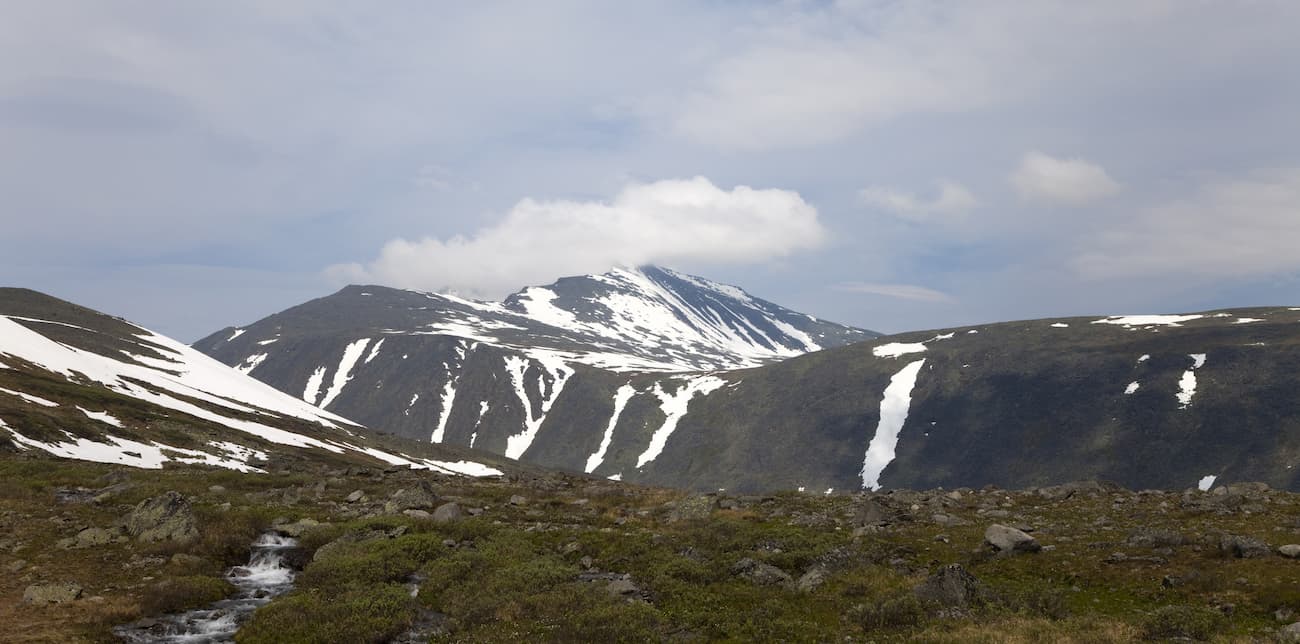
Mesmerizing with its beauty and inaccessibility, it attracts many tourists and fans of active recreation. This majestic mountain is quite remote from the settlements, so getting to it is not an easy task. The mountain is located in the Yugyd Va National Park , so it is necessary to register in advance and get a visit permit from the park administration. How to get to the park administration and get a permit, read the article on the Yugyd Va National Park .
Mountain Zaschita (1,808 m) is the second-highest peak in the Ural Mountains, after Mount Narodnaya . Mysteriously, the name of the mountain, which roughly translates as Defense or Protection Mount, does not correlate in any way with the Mansi names of the nearby mountains and rivers. The origin of the name is unknown. There are some speculations but we will consider just one of them. On the map of the Northern Urals which was made by the Hungarian researcher Reguli the closest peak to Mount Narodnaya was called gnetying olu. Its location coincides with that of the present-day Mount Zaschita . The name gnetying olu in the Mansi can be deciphered as a mountain on which there is some help from ice. The mountain is believed to protect deer grazing on glaciers from mosquitoes. So, early topographers called the mountain more briefly – Mount Defense. Indeed, the slopes of this mountain are covered with a lot of snow and glaciers (the Yugra, Naroda, Kosyu, Hobyu glaciers and others). And it is here that the Mansi shepherds bring their deer which can rest on glaciers and snow. Summarizing all the above, we can say that Zaschita Mount is to some extent protection for deer from mosquitoes. The very name Zaschita appeared on maps with the beginning of hiking tours in the Subpolar Urals.
Mount Neroyka (1,645 m) is 100 km from Neroyka village, the closest tourist base to this peak. In the 1950s, people who were engaged in quartz mining near the mountain worked and lived in this base. Later, a gravel road was built from the village of Saranpaul to the mountain for large-scale development of the quartz deposit. In recent years, the road has not been much used and is practically not cleaned from snow in winter. There has been a plant built 20 km down from the mountain for primary processing of quartz with the use of nanotechnologies. There is an annual big camping event near the mountain. It is organized by the Tourism Department of the Khanty-Mansi Autonomous Area. You can have a 1-hour helicopter ride to the mountain from the village of Saranpaul. Should you wish to fly from the city of Khanty-Mansiysk , be prepared to fly over the taiga for 2.5-3 hours.
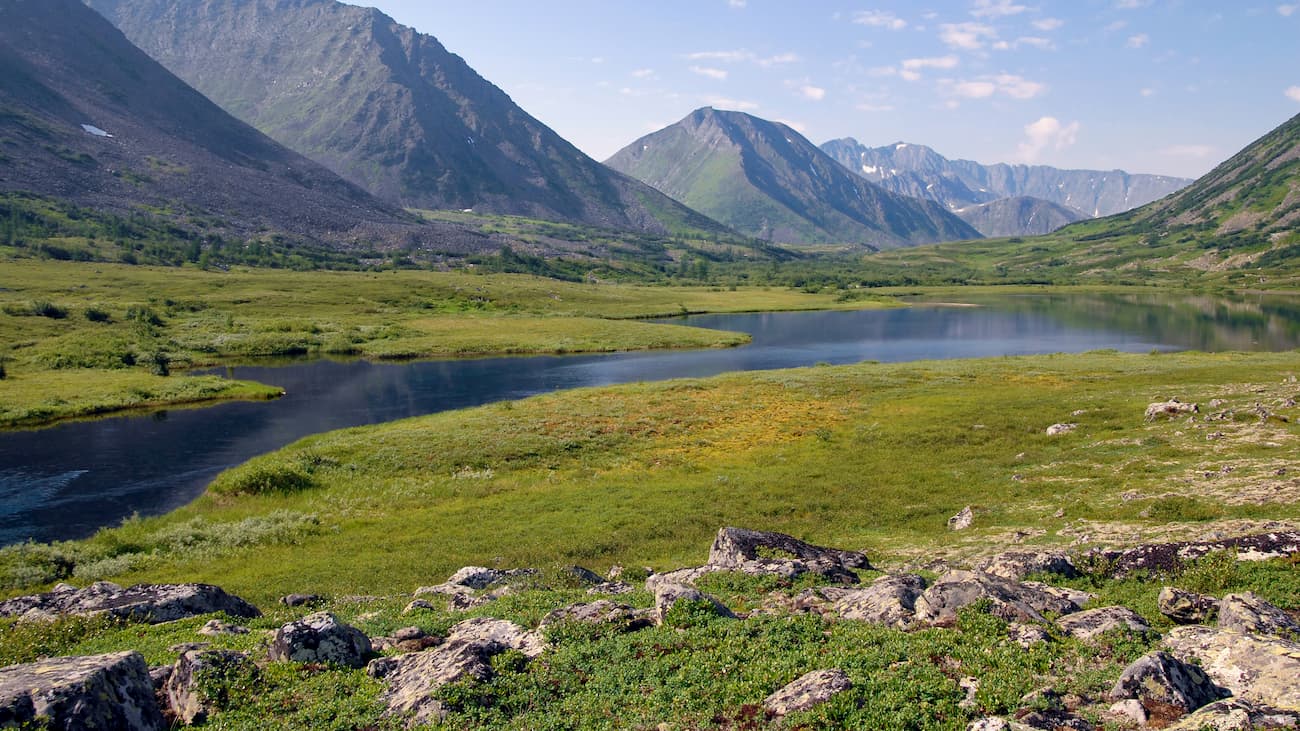
Quite inquisitive tourists happened to discover, by a lucky chance, a Pyramid similar to that of Cheops but four times bigger. It is located on the territory of the Narodo-Ityinsky Ridge. The closest to the pyramid is the village of Saranpaul. The sizes of the found pyramid are as follows: the height is 774 m, in comparison to the Egyptian pyramid which is 147 m; the length of a lateral edge is 230 m whereas the Egyptian pyramid is 1 km. The pyramid is located precisely according to the cardinal directions, there is not a single degree deviation at that. The origin of the pyramid is unknown, scientists are still making assumptions. No traces of human activity were found near the pyramid. The only way to get here at this time is by helicopter.
Samarovskaya Mountain is another wonder that is baffling many people. It is dividing the city of Khanty-Mansiysk into northern and southern parts. Few now living residents know that in the old days the highest part of the modern city used to bear a plural name of the Samarovsky Mountains among which there were Mount Palenina, Komissarskaya, Miroslavskaya, Filinova, and Romanova. Originally, there was a village called Samarovo amidst these mountains. Until now, many issues bewilder both residents and scientists. How could a mountain form in the middle of the West Siberian Plain? What is inside it? Won't the weight of the buildings erected on the top of the mountain affect its height? The uniqueness of Samarovskaya Mountain is that it consists of numerous large stones, boulders, rocks that are absolutely foreign to this area. Scientists have not yet come to a consensus on the mountain’s origin.
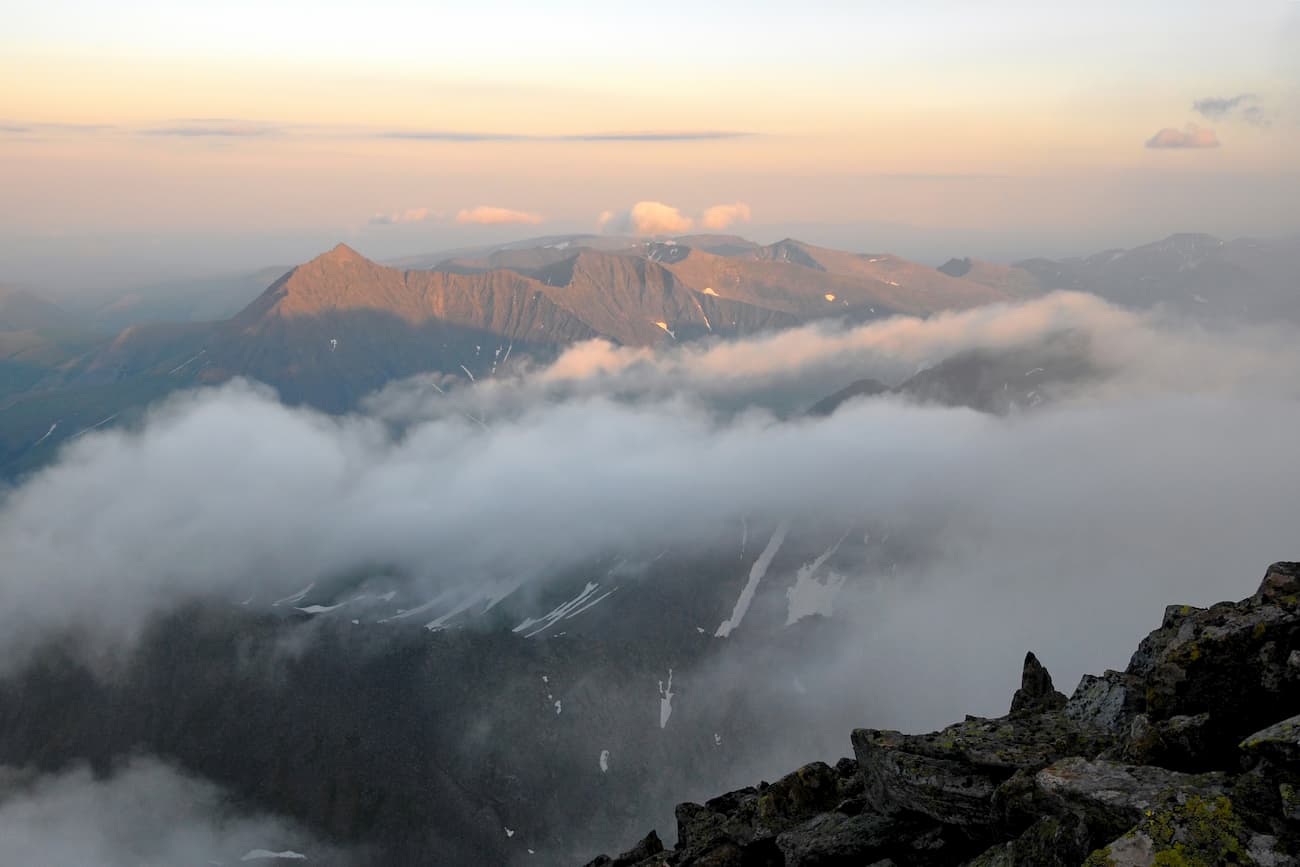
The Yugra is very famous for its ski resorts, the main of which are:
- The Cedar Ravine ski resort (Surgut city, Naberezhny Ave. 39/1)
- Three Mountains (Trekhgorie) ski resort (30 km from Nizhnevartovsk, Ermakovsky settlement)
- Stone Cape (Kamenniy Mys) ski resort (near the city of Surgut)
- Pine Urman ski resort ( Khanty-Mansiysk , Sportivnaya Str., 24)
The far-away lands of the Yugra are the blessed sanctuaries for many animals as the area is rather hostile to a human There are reserves, natural parks, wildlife sanctuaries here that aim to protect the national treasures of the lands. Having visited these regions once, you would crave for coming back again and again to feel that unique sense of unity with nature, to forget about the urban fuss and and hustles whatsoever. The harsh but beautiful nature of this extraordinary area leaves an indelible trace in the soul of every person.
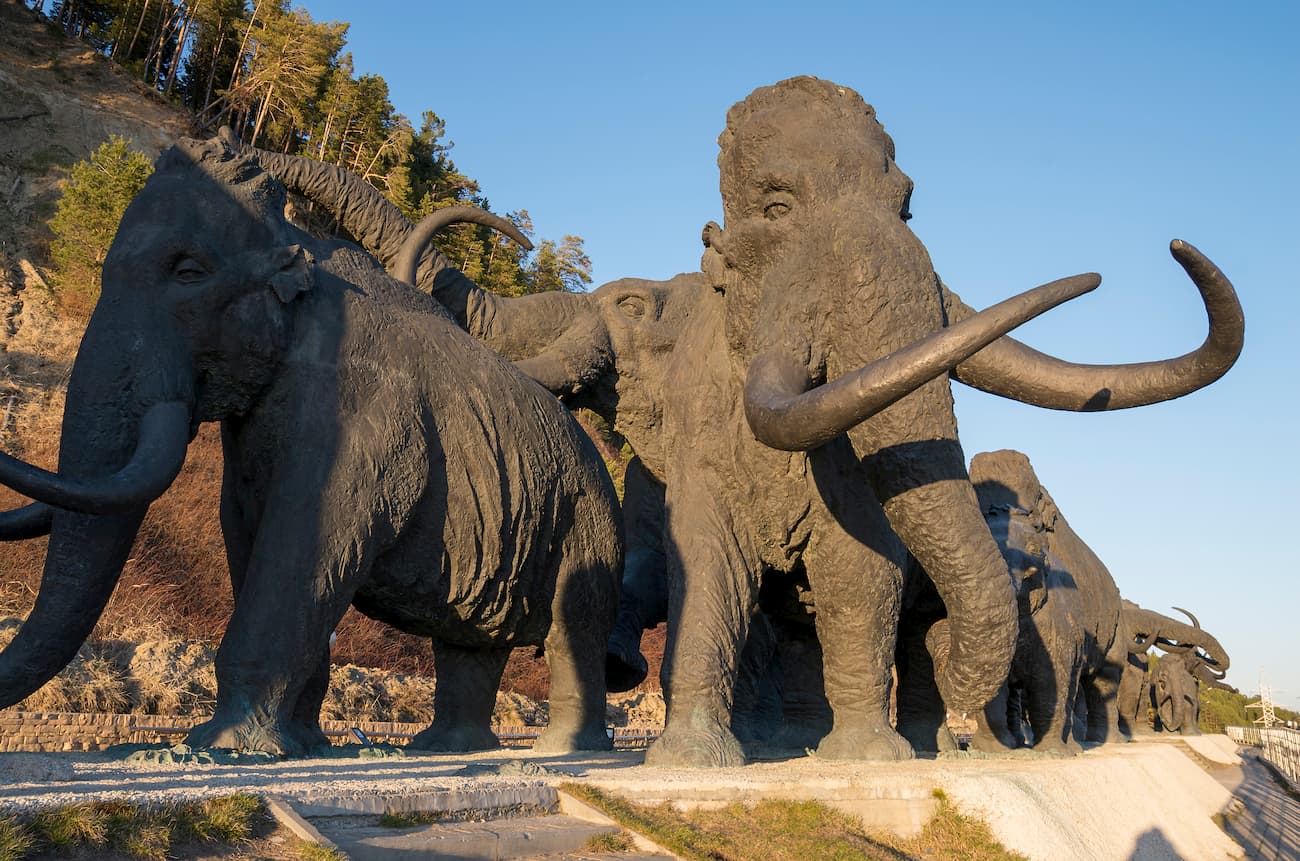
On the territory of the district there are 25 specially protected natural areas, the most famous of them are:
- The reserves are two: the Malaya Sosva Reserve and the Yugan Reserve, the latter was established in 1982 as the largest reserve of taiga landscapes. The purpose of the reserves was to study unobtrusively and carefully preserve the endemic flora and fauna without disturbing natural processes. Hunting and economic activities are prohibited here, which is important for the preservation of natural ecosystems.
- The natural parks are the Samarovsky Chugas Nature Park, the Siberian Sloping Hills (Uvaly), the Numto (also called Lake Numto), and the Kondinskie Lakes.
These reserves and natural parks offer tourists their own excursion programs to make visiting their territory much more enjoyable and educational.
The Samarovsky Chugas Nature Park is located in the center of Khanty-Mansiysk , on a small hill between the Ob and Irtysh rivers.
The territory of the Siberian Sloping Hills (Uvaly) natural park is 350 km away from the city of Khanty-Mansiysk . You can get there by helicopter or by plane. The office of the park is located at 7a Pionerskaya Street, Nizhnevartovsk.
The Kondinskie Lakes Natural Park is located 380 km from Khanty-Mansiysk . Half of the park is covered with swamps, but there is also a recreational area. There you can rest, swim, do some amateur fishing, picking berries (cowberries, cranberries) and mushrooms is permitted. There is only one independent walking route here, it runs for 3 km in the deep forest. It is a cool place for kids since the park is equipped with sports grounds, a pool and a small zoo where the kids can interact with brown bear cubs. What else, try the TaiPark, it is a rope course running at the height of 2.5 meters, having 15 stages, the full length is 125 meters. There is an opportunity to order water walking tours in the town of Sovetsky, which can be reached by train from Khanty-Mansiysk .
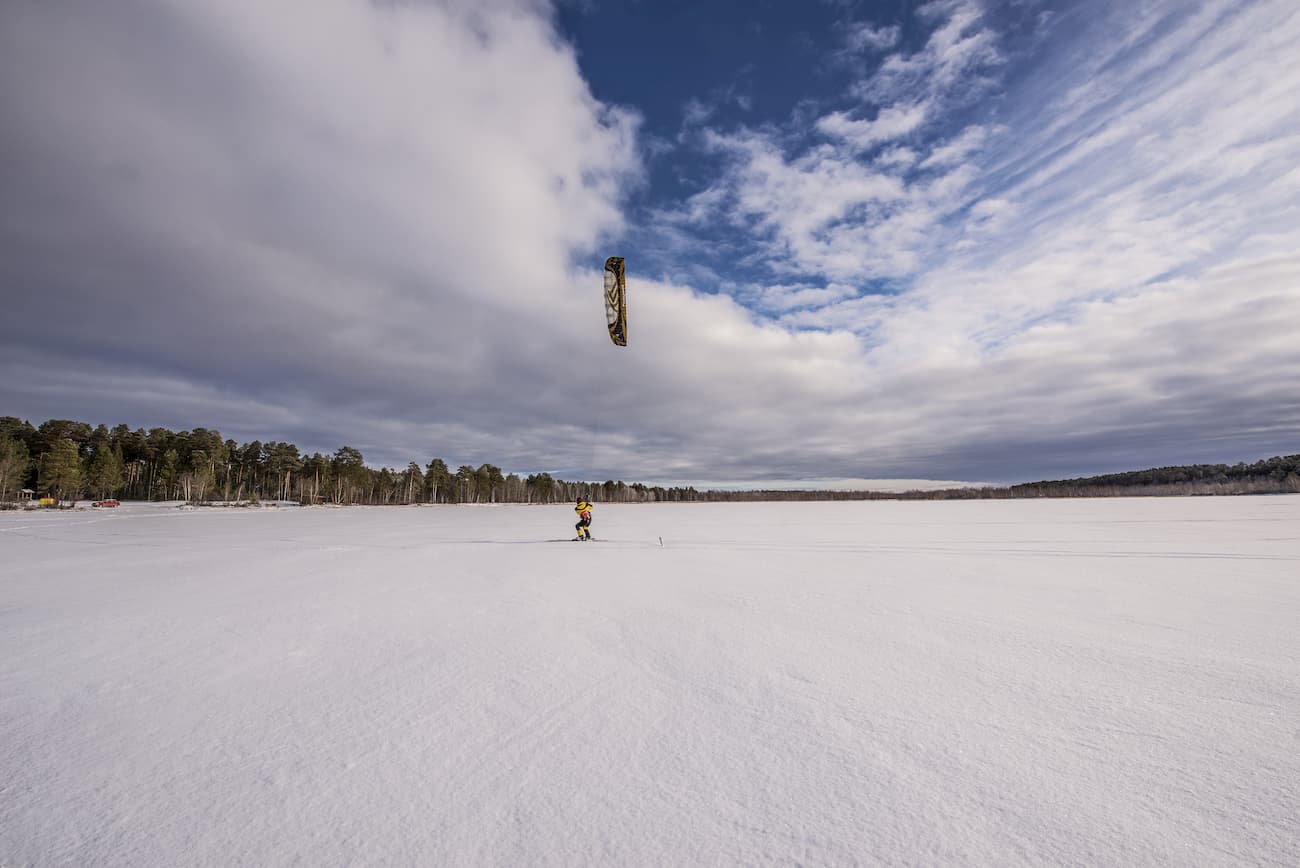
The Numto Nature Park is located almost in the center of the West Siberian Plain, in the Beloyarsk district of the Khanty-Mansi Autonomous Area, 300 km from the city of Surgut and 200 km from the town of Beloyarsk. It is located on the border of Yugra and Yamalo-Nenets Autonomous Area. The administration of the park is located at 2, Beloyarsky micro-district, 4a. The territory of the natural park is a treasure trove of archaeological and ethnocultural monuments. As of today, there have been discovered 20 architectural monuments, including fortified and not fortified settlements, places of worship abandoned by the peoples who lived here from the Stone Age to almost the present day. Researchers have also found 65 monuments of ethnic value, the main of which are worship objects, sacred places and cemeteries.
The Malaya Sosva Reserve includes several subordinated territories and sanctuaries, including Lake Ranghe-Tour. The reserve offers a 4-km walking guided route that gets the visitors introduced to the typical features and characteristics of flora and fauna of the region. The route is called Bear Trail and you can spot bears there (don’t come close though, we’ve already written how to behave if you meet a bear in the wild). Also, you will see the River Malaya Sosva, some marshes, ancient cultural monuments and other nice sights. Permission to visit the reserve can be obtained from the administration of the reserve at Lenina Str. 46, town Sovetskiy.
As to the Yugan Nature Reserve , it is inaccessible to common hikers who are afraid of flying since there are no roads to it. The only way to get there is taking a helicopter ride. You also must obtain a permit in the administration of the reserve, go accompanied by employees of the reserve, and only on special transport of the reserve (motorboat, snowmobile). The central manor of the Reserve and the administration are located in the village of Ugut. To get to this village, you should first go to the town of Surgut, then go to the town of Pyt-Yakh, and from it there is a road to the village of Ugut. It is about 100 km from Ugut to the southern border of the reserve i, and another 25 km to the nearest cordon. The administration works from Monday to Friday. You can request a permit via mail at [email protected] , order a guided tour at [email protected]
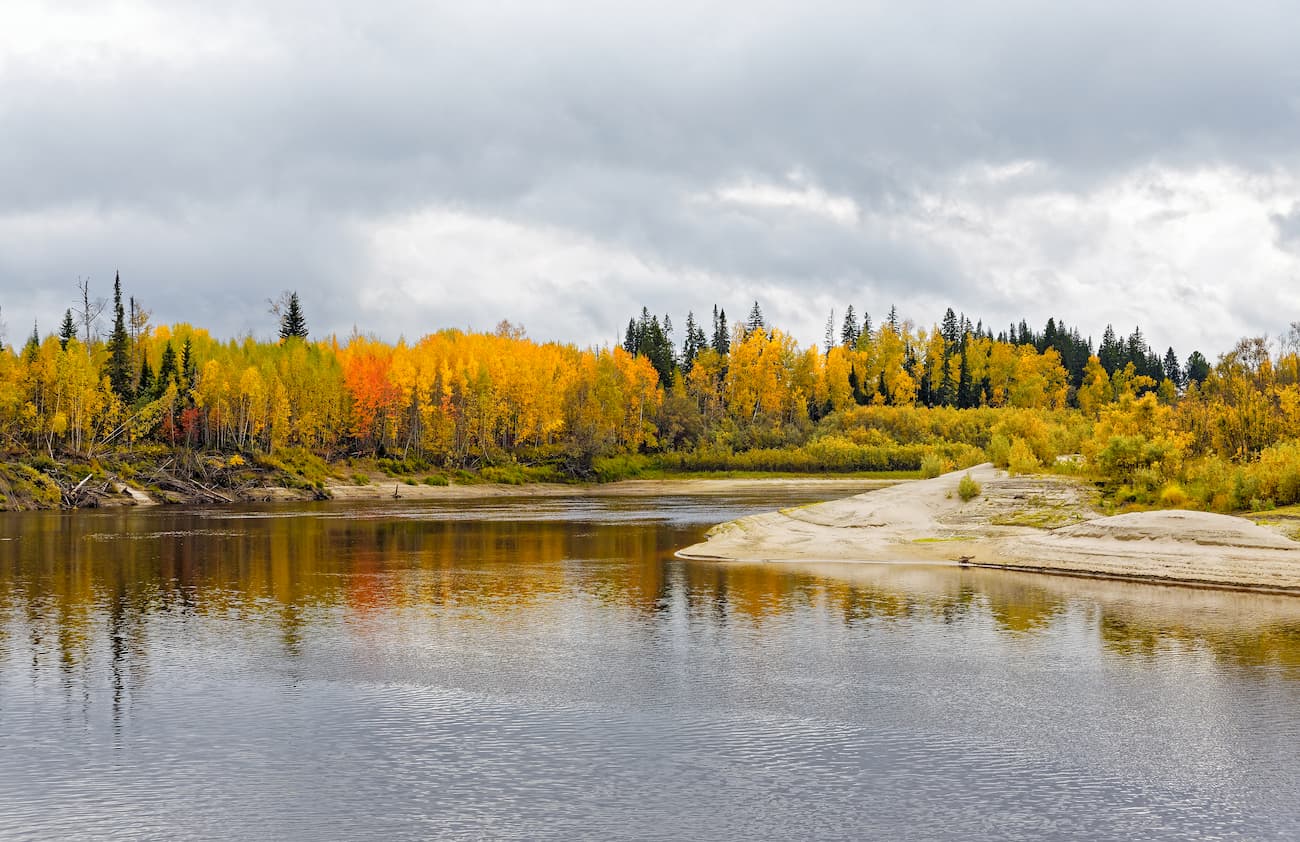
The Yugra lands are heaven for water sports aficionados. They can have some awesome fishing or go rafting along such rivers as: the river Naroda, the Deep Sabun, etc.
The Naroda River is 140 km long. It is the left tributary of the Manya River located in the Ob River basin. The river has its origin on the south-western slope of Mount Narodnaya . It is a mountain-taiga river with rapids, swifts, numerous rolls, which attracts interest among water tourists. However, it is usually not rafted very often.
The Deep Sabun River flows through the territory of the Siberian Sloping Hills Nature Park. The park has developed multi-day water routes. It is possible to raft along the river in summer and to go skiing along it in winter.
The Kondinskie Lakes are a system of lakes along the left bank of the Konda River. The largest lake is the Arantur, with pine forests on the northern side and sandy beaches well equipped for a nice relaxing me-time. The water heats up well in summer. The small river Okunevaya and the river Maly Akh flow into the lake. The Maly Akh comes in on the west side and connects lake Arantur with Lake Pon-Tour. This lake is the richest in fish, and there is also a parking lot for fishermen here. The streams connect Pon-Tour with small lakes Krugloe and Lopukhovoye. When you look at Lopukhovoe lake, you feel as if you have found yourself in a fabulous place: more than half of its surface is covered with white lilies, as well as yellow flowers of the water-beans. Then the river Big Akh, which flows into the river Konda, connects all the lakes into a single system. Along the river there are many archeological monuments such as forts and settlements which have paths to them. The southernmost lake of the park is Ranghe-Tour.
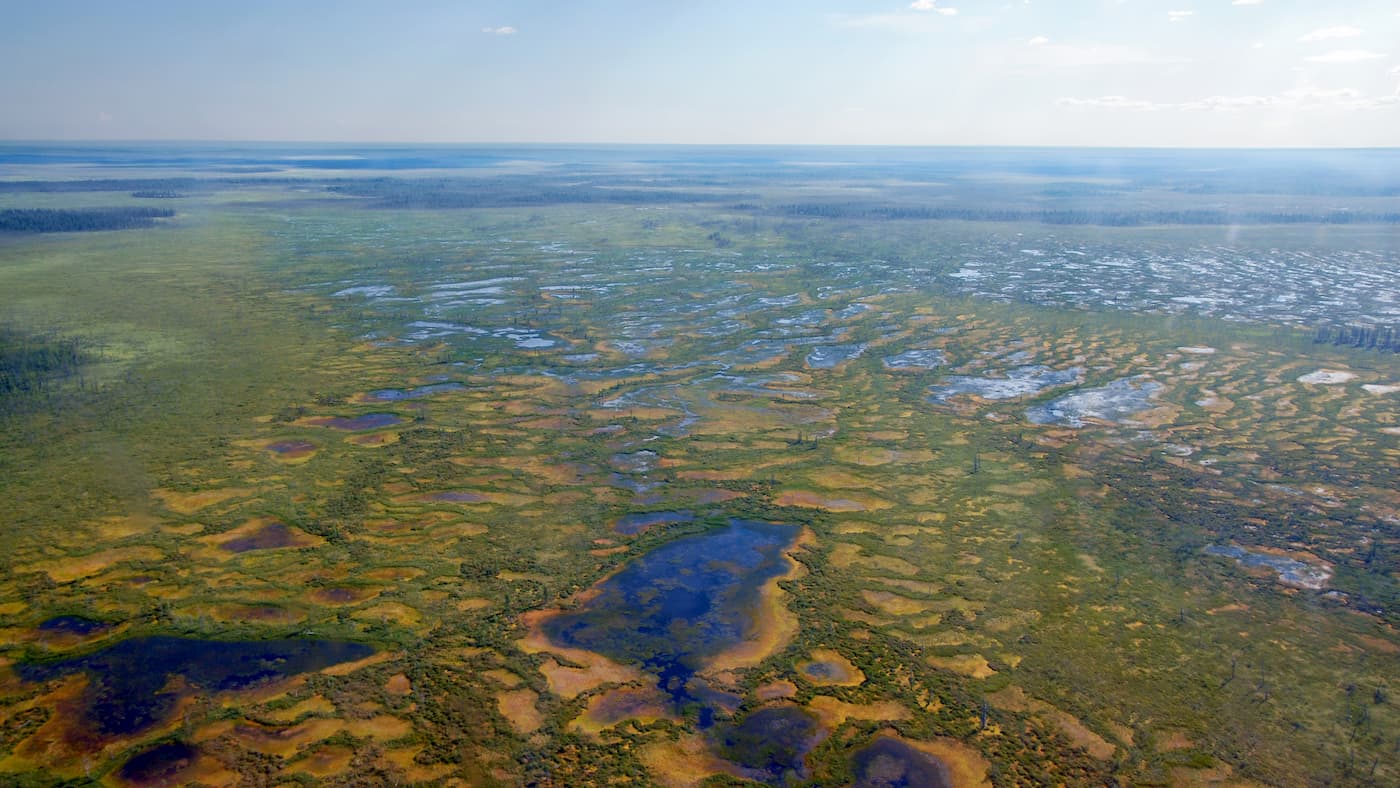
Yugra is not the easiest destination and not the most accessible, but the effort is well worth it. You should first get to the capital of Khanty-Mansiysk Autonomous Area – the city of Khanty-Mansiysk either by air or by train.
Khanty-Mansiysk is based on the premises of the former village Samarovo founded in 1582. It used to be the territory of the Khanty people and a pit stop for coachmen who rode their wagons across the country. The village was founded by Russian Count Samara, thus the name Samarovo. The modern city actually began to develop in 1930 because amidst the Siberian taiga there finally started to appear stone houses on the high bank of the Irtysh River. In 1940, the village was renamed into Khanty-Mansiysk by the name of the peoples living on this territory – the Khanty and the Mansi, and in 1950 it received the status of a town.
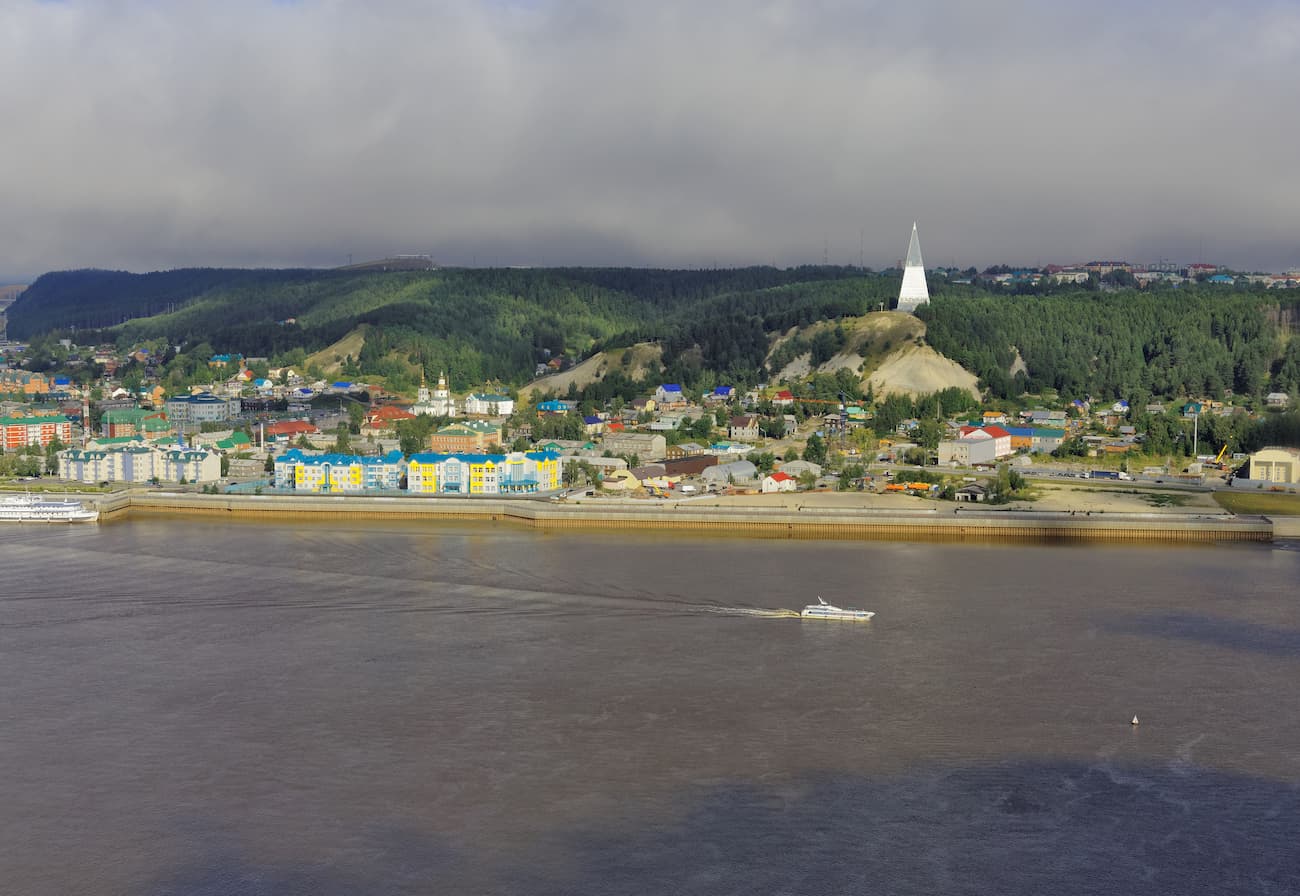
The city has several attractions. Mount Samarovskaya is probably the biggest natural and scientific wonder. It divides the city in two parts and causes many concerns for urban developers who always wonder whether this mountain can move making the buildings slide or even sink in.
Another beauty is the century-old cedar grove that is within the city limits. The grove is a part of the natural park Samarovsky Chugas. The word chugas in the language of the Khanty means a lonely hill in the low river floodplain.

The park is one of the main attractions of the city, it hosts an open-air ethnographic museum called the Torum Maa, a cultural and tourist complex called Archaeopark, a biathlon center. Kids and adults, nature lovers and fans of culture love this place dearly.
A memorial sign to Yugra's discoverers is installed on top of the Samarovsky Chugas. It is a tall stele pyramid divided into three portions. On the lower level, there is a restaurant, on the second level is a small museum, and on the third level there is an observation deck, 40 m above the ground, with a magnificent view of the Irtysh River and the river port. The pyramid is decorated by the bas-relief depicting the discoverers of the region, from the 16th-century Count Samara to the geologists of the 20th century.
Another trademark of Khanty-Mansiysk is the State Museum of Nature and Man. The museum hosts a gallery and a workshop of a famous artist G. Rayshev.
The city has a lot of small monuments generously spread around the city. There is the Khanty family resting on a camp, this monument is near the airport building. You can take a pic at the Golden Tambourine located at the intersection of Gagarin Street and Mira Street. Connoisseurs of culture should also visit the Sun – the Theatre of Ob-Ugrian Peoples, it is the world's first professional theatre of Khanty and Mansi peoples. And if you are travelling with kids, the Khanty-Mansiysk Puppet Theatre is a must-visit. In the period from May to October, you can take a boat ride to the confluence of two rivers – the Ob and the Irtysh. Yugra Service Co. operates such cruises, you can find more information locally at their address Tobolsk Trakt street 4, Khanty-Mansiysk .
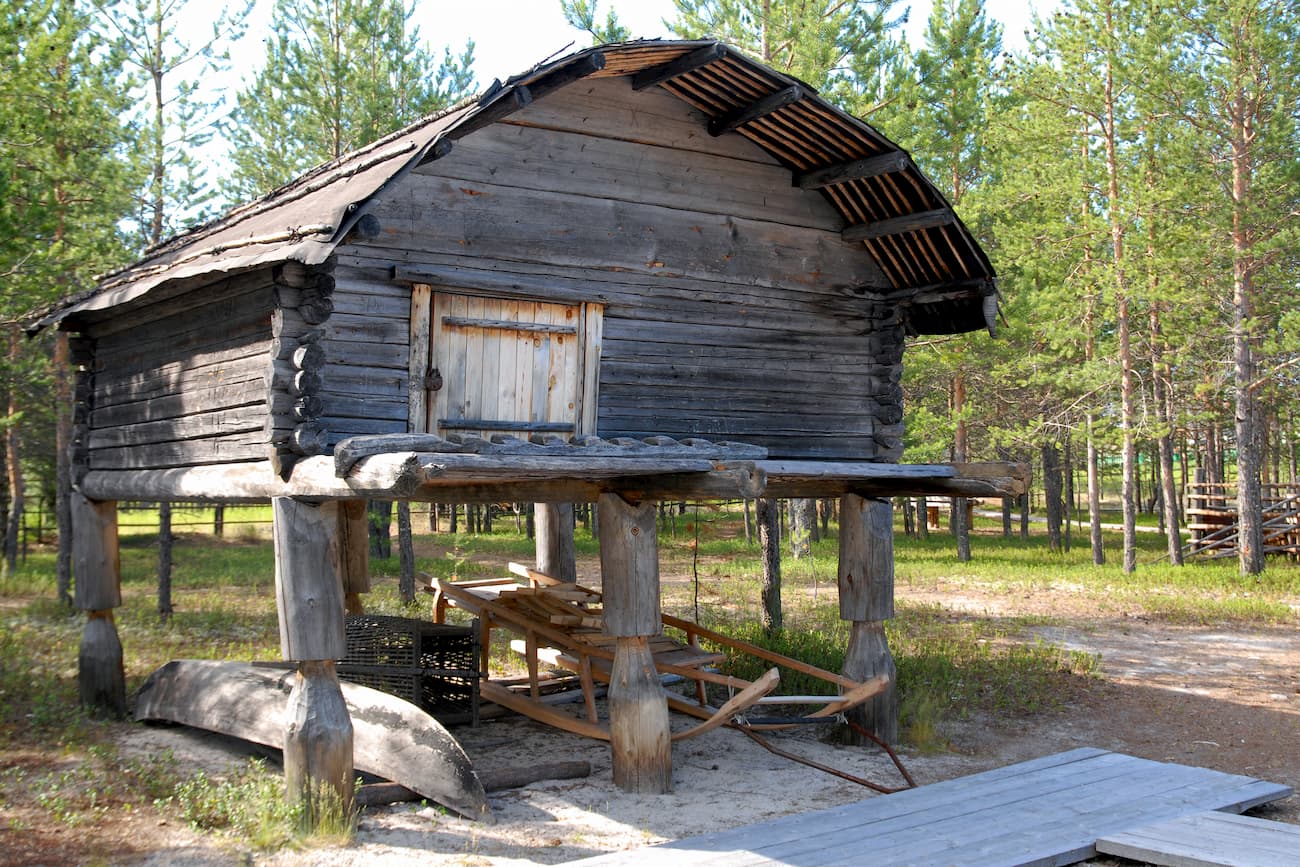
Explore Khanty-Mansiysk Autonomous Okrug – Ugra with the PeakVisor 3D Map and identify its summits .

PeakVisor Hiking Maps
Be a superhero of outdoor navigation with state-of-the-art 3D maps and mountain identification in the palm of your hand!
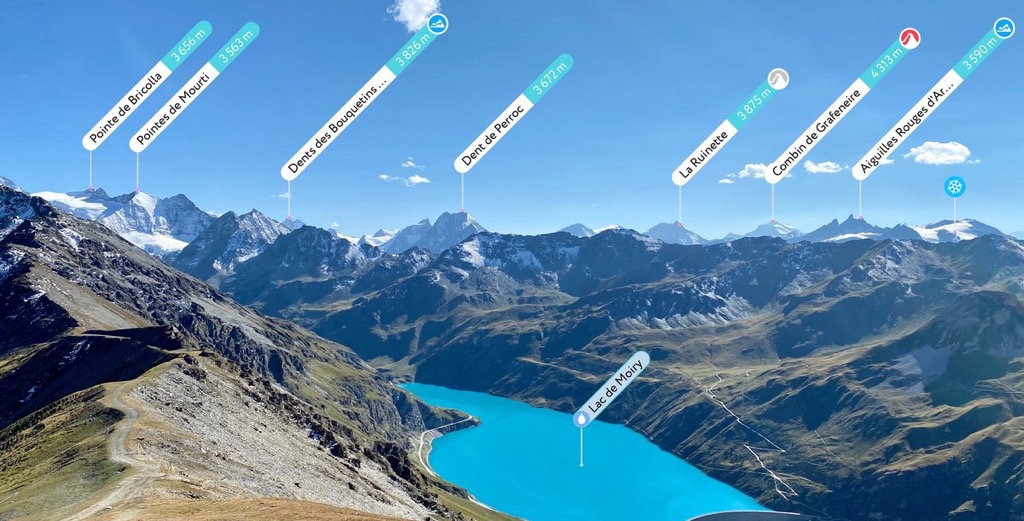

COMMENTS
Schindler House Companion Tours. Learn more about the Schindler House through a series of interpretive audio tours by artists, architects, and writers. Visitors are invited to move, observe, and perceive the house through instructional exercises, fictional meanderings, and guided journeys.
Each house on the tour has been carefully restored to preserve the original design. Schindler's Goodwin House (1941), Presburger House (1945), and Kallis House (1946) are joined by Lautner's Jacobsen House (1947). An VIP reception will follow at the contemporary Laurel Hill Residence (2019) designed by Assembledge+.
The MAK Center for Art and Architecture operates three significant architectural sites with distinct hours and policies of admission. SCHINDLER HOUSE. Wednesday: 11am-6pm. Thursday: 11am-6pm. Friday: 11am-6pm. Saturday: 11am-6pm. Sunday: 11am-6pm. Please check the Hours for information on parking, holiday and special event closures.
The Schindler house is widely considered to be the first modern house. The flow of space and unique uses of spatial arrangement, finish materials, lighting and intersecting lines are incredibly fascinating. The house is 90 years old and looks like it could have been built yesterday, instead of in the height of the Colonial Revival and Bungalow era.
also known as the Kings Road House or Schindler Chace House, located in West Hollywood, California was designed by architect R. M. Schindler. The Schindler House is considered to be the first house ever built in the Modern style. Schindler House 835 North Kings Road, West Hollywood, California 90069-5409. tel: 323 651 1510 fax: 323 651 2340 ...
Follow Us: Behind a bamboo grove, the Schindler House offers a tranquil setting for meetings, receptions and parties. A modern masterpiece designed in 1922 by R. M. Schindler, it features sliding doors opening onto courtyards, outdoor fireplaces and lush landscaping. Contact Information. 835 N. Kings Rd., West Hollywood 90069. 323-651-1510. Hours.
July 14, 1971. The Schindler House, also known as the Schindler Chace House or Kings Road House, is a house in West Hollywood, California, designed by architect Rudolph M. Schindler. [2] The house serves as headquarters to the MAK Center for Art and Architecture, which operate and program three Schindler sites, and is owned and conserved by the ...
The house, designed by famed architect Rudolph Schinder, was built in 1922. It was designed as a communal space for two couples - Schindler and his wife, Pauline and Clyde and Marian Chace. Schindler stayed in the house until his death in 1953 and Pauline remained through the 1970's. In 1980 the house was acquired by the non-profit Friends ...
Tours and programming are operated by the MAK Center for Art and Architecture, an L.A. outpost of the Museum for Applied Arts, in Vienna. The Schindler House has aged into a becalmed, almost ...
By Carolina A. Miranda Columnist. June 15, 2022 6 AM PT. The history of Rudolph Schindler's 1922 house is a quintessential Los Angeles story: a story of new ideas that are rapidly devised and ...
The Schindler House Companion Tours are a series of interpretive audio tours by artists, architects, and writers. The audio projects challenge the status of the house tour as a mode of institutional address and authoritative voice by commissioning contemporary practitioners working in text, choreography, sound, and storytelling to offer new ...
MAK Center at the Schindler House the house gallery history 100 years events gatherings Schindler Talks... connect legacy donate Open Menu Close Menu. Folder: the people. Back. RM + Pauline Schindler Friends of the Schindler House MAK Center at the Schindler House ...
The most noteworthy of those that remain are highlighted in this Artforum driving tour. Bringing home the uniqueness of Schindler's career, it traverses hills, hills, and more steep hills. Unlike Neutra's clients, Schindler's could rarely afford the best lots. ... R. M. Schindler, Harris House, 1942-44. Photo: Julius Shulman, 1942. Inset: ...
Unexpected Application Error! Step inside our latest home tour, the historic Schindler House in Los Angeles, California. Our new collections offer a fresh take on classic mid-century, Japanese and Scandinavian inspired design with blonde wood finishes, floral and geometric textiles, natural fibers and more.
Cameraman Pierluigi Serraino surveys the first stage of restoration work at the Schindler House on Kings Road in 1986. Workers are demolishing later addition...
The Schindler Factory still stands, as does its owner's wartime apartment and the eerie house that was the residence of Camp Kommandant Amon Goeth. Spielberg shot his movie 'Schindler's List' here in Krakow, using many locations that Schindler knew intimately. Our tour combines insights into Spielberg's film with historical details of ...
A day long self-guided tour of homes and apartments reflecting the evolution of R.M. Schindler's work over three decades. Sites included: The Schindler House (1922), The How House (1925), The Oliver House (1933 - 1934), The Buck House (1934), The De Keyser Duplex (1935), The Mackey Apartments (1939), The Rodriguez House (1940 - 1942), The Kallis House (1946), and The Tischler House (1949 ...
Located on seven hills about 20 kilometers from the confluence of two great Siberian rivers - the Ob and Irtysh, it has a unique natural landscape. The population of Khanty-Mansiysk is about 106,000 (2022), the area - 10.5 sq. km. The phone code - +7 3467, the postal codes - 628000-628991.
According to Irina Pudova, a local resident and the author of a collection of legends called Yugra: It's My land, the first thing to do in Khanty-Mansiysk is to see the local mammoths. Seven ...
Tickets. Advance timed-entry tickets to the Schindler House are highly recommended. Walk-up tickets are available, but timeslots do sell out and may not be available. Please check our ticketing calendar and hours page for availability and admission hours. If no tickets are available on the calendar, it means we are sold out or closed for the day.
Khanty-Mansi Autonomous Okrug — Yugra [a], commonly shortened to Khantia-Mansia, is a federal subject of Russia (an autonomous okrug of Tyumen Oblast).It has a population of 1,532,243 as of the 2010 Census. [4] Its administrative center is located at Khanty-Mansiysk.. The peoples native to the region are the Khanty and the Mansi, known collectively as Ob-Ugric peoples, but today the two ...
The Khanty-Mansiysk Autonomous Area (KhMAO) was established in 1930. Its name comes from two main northern indigenous peoples - the Khanty and the Mansi. From 1944 it was legally part of the Tyumen Region, but in 1993 the Area received autonomy and became a full-fledged territorial entity of the Russian Federation.
The Center is headquartered in the landmark Schindler House (R.M. Schindler, 1922) in West Hollywood; operates a residency program and exhibition space at the Mackey Apartments (R.M. Schindler, 1939) and runs more intimate programming at the Fitzpatrick-Leland House (R.M. Schindler, 1936) in Los Angeles. The MAK Center is the California satellite of the MAK - Museum of Applied Arts in Vienna ...